Marvel has released episode three of WandaVision, and while fans have reveled in the many, many new clues offered up, it’s still not entirely clear just what is happening to Wanda and Vision. Or her memory of Vision. Or resurrected Vision. Or… whoever that is sharing Wanda’s “dream home” in Westview.
One thing that has come into clear focus: WandaVision is moving somewhat relentlessly through the history of American situation comedies (or sitcoms, to use the vernacular). And if, as it seems likely, Wanda is in some sort of peril, it is understandable that she might comfort herself in a world based on sitcoms, where people wear lovely clothes, live in tastefully decorated homes, drive new cars, and where any problem can be resolved in 30 minutes (minus the commercial break, of course).
This article will not make any effort to figure out how or why Wanda and her dashing companion Vision are making this journey. But it will take a fairly deep dive into just which sitcoms are influencing the narrative. Spoiler Alert: There will be a section at the end of this article looking ahead at future episodes (so far we have seen only three of the nine episode announced by Marvel). There will be an alert in the article for those who prefer to wait and be surprised by the new episodes.
According to the theme song in episode one, Wanda and Vision are newlyweds, newly arrived in a bucolic small town somewhere beyond a dense forest. Many sitcoms were set in small towns, with names designed to belie their actual location. Whether it was Mayberry, Mayfield, Danfield, Springfield, Warfield, Lanford, Hilldale, or Westbridge*, you could rely on encountering a stock company of personable neighbors living in tidy homes and leading equally tidy lives.

As Wanda and Vision arrive in town during the title sequence of episode one, there is a glimpse of a billboard welcoming them to their new hometown.
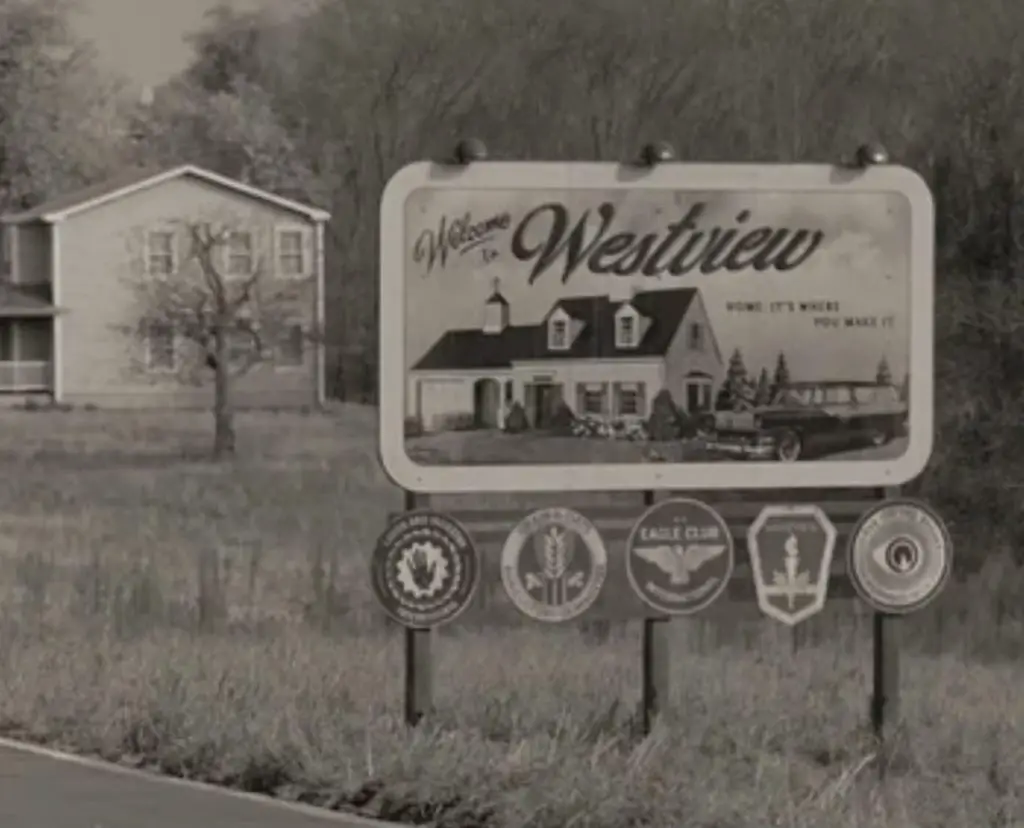
A closer look reveals that WandaVision is set in Westview, whose town motto appears to be “Home: It’s where you make it.” (Anyone else notice that WandaVision and Westview share the same initials, WV?)

This billboard also turns up in animated form in the title sequence of episode two.

And there is a slightly disturbing version of the sign seen at the end of episode three, suggesting that Westview just might be a real location, after all. Or not.
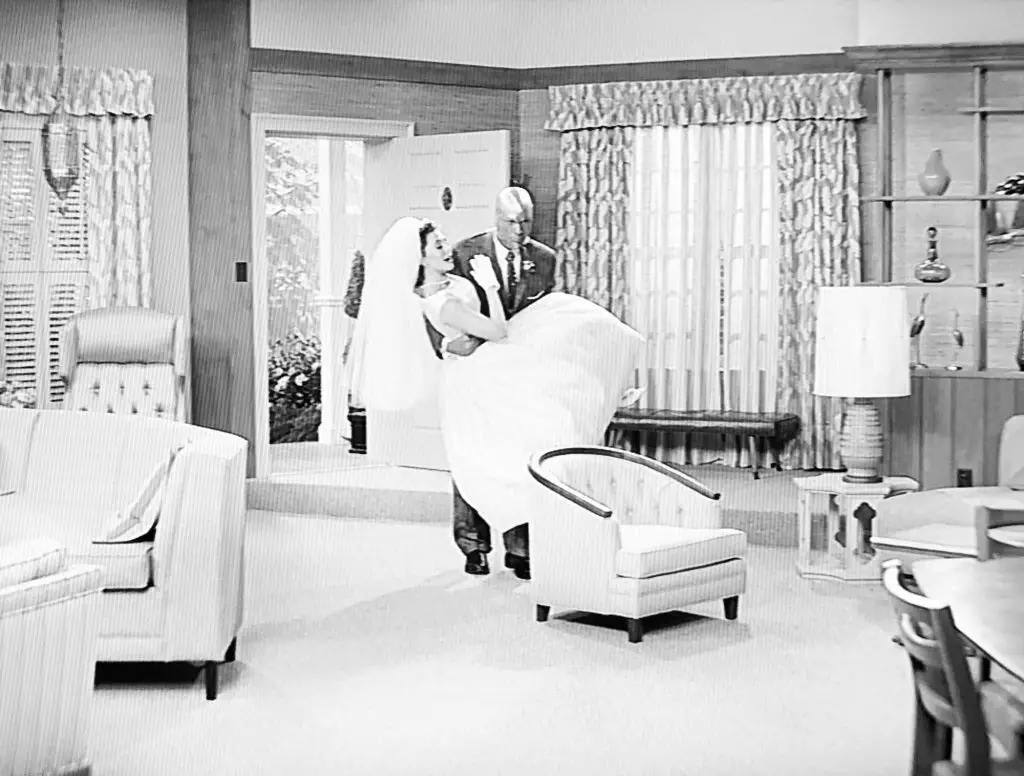
Wanda and Vision’s arrival at home borrows a very memorable moment from a long running series. Dick Van Dyke, as Rob Petrie, had to deal with a misplaced ottoman in the opening of his program. In WandaVision, the confrontation is with a chair.
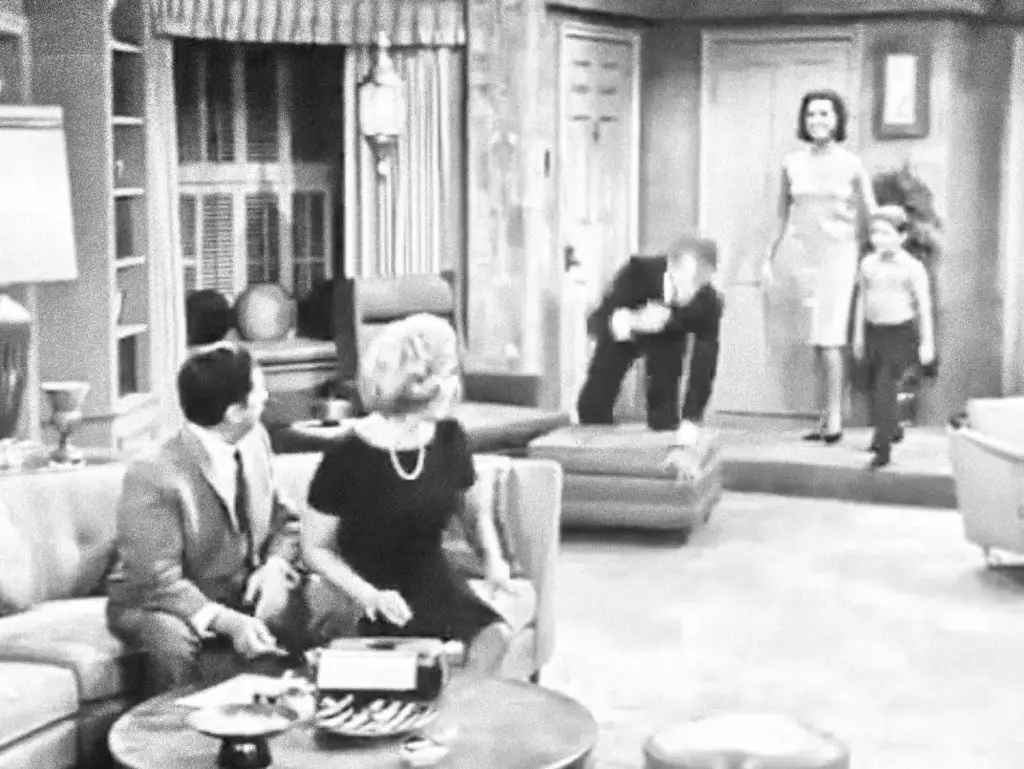
Rob took a fairly spectacular pratfall during the early seasons (a tribute to Dick Van Dyke’s ability for physical comedy).

In later season, Rob deftly sidesteps the ottoman (and then goes on to shake Buddy’s hand twice).
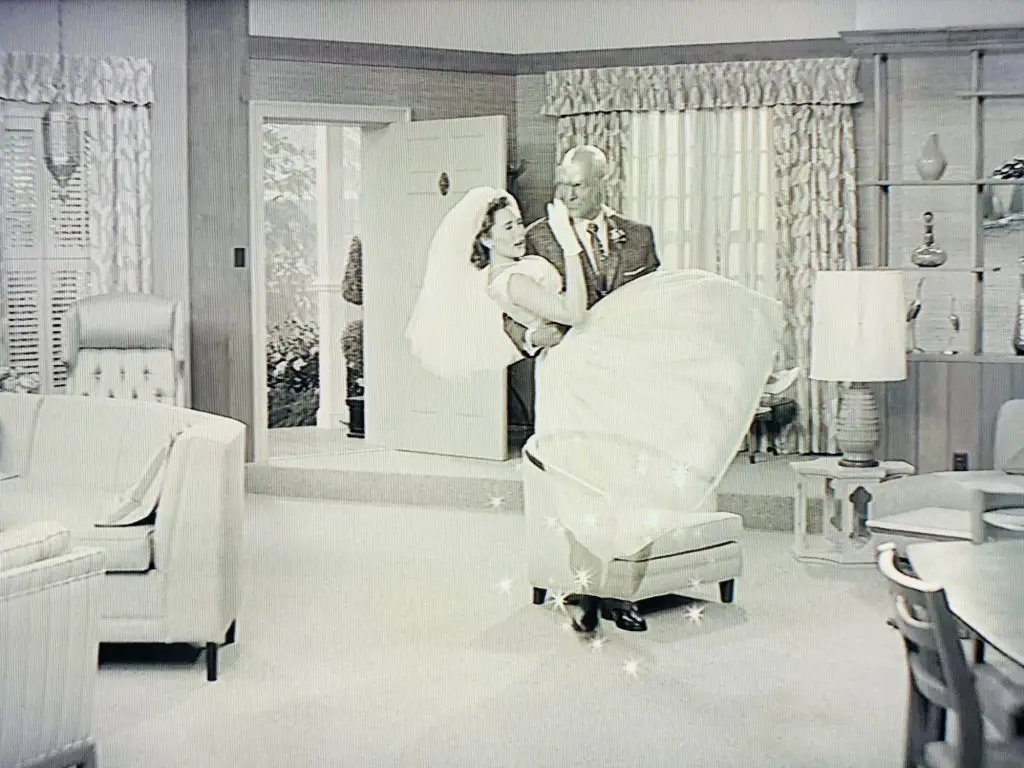
Vision avoids the whole dilemma by simply walking through the chair.

The kitchen for episode one is instantly recognizable as Laura Petrie’s in The Dick Van Dyke Show. Rather than a slavish imitation, it is instead something of a deconstruction of basic elements, almost as if this is put together out of elements that have been half remembered.

Seen here on The Dick Van Dyke Show, the kitchen island is “flipped,” and other elements have been rearranged.
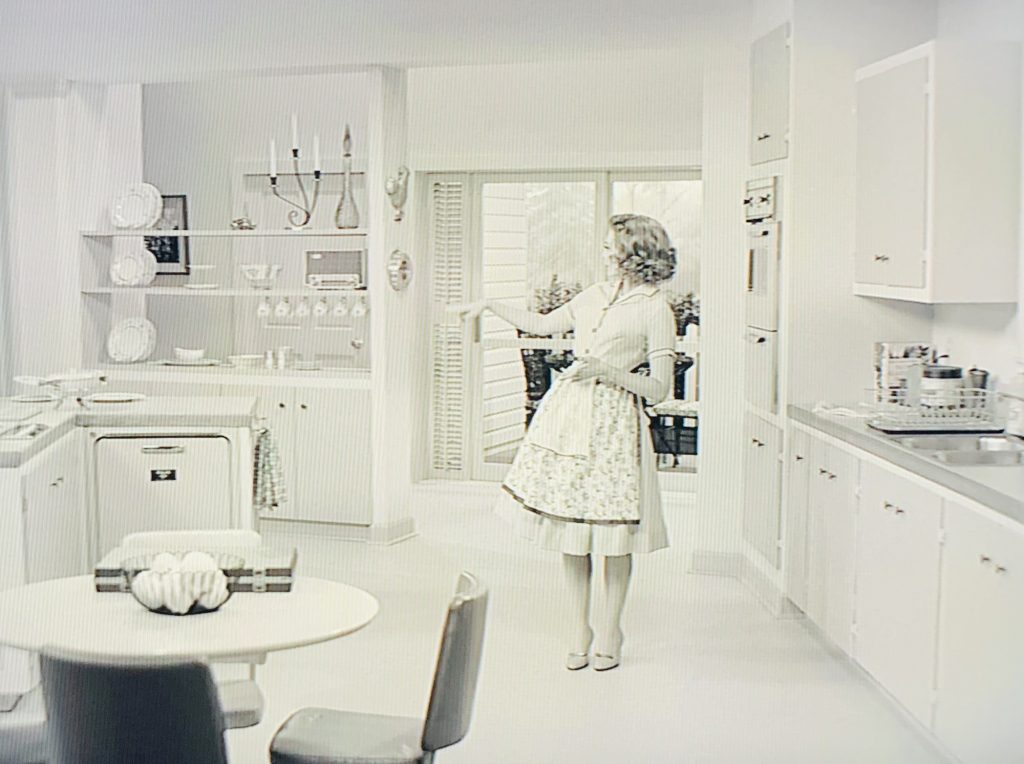
Wanda’s kitchen…

… and Laura’s kitchen.
The same is true of the other side of the room, particularly in the open shelves that have switched sides in the background.

The WandaVision dining room is also a near duplicate of its model in the Petrie house.
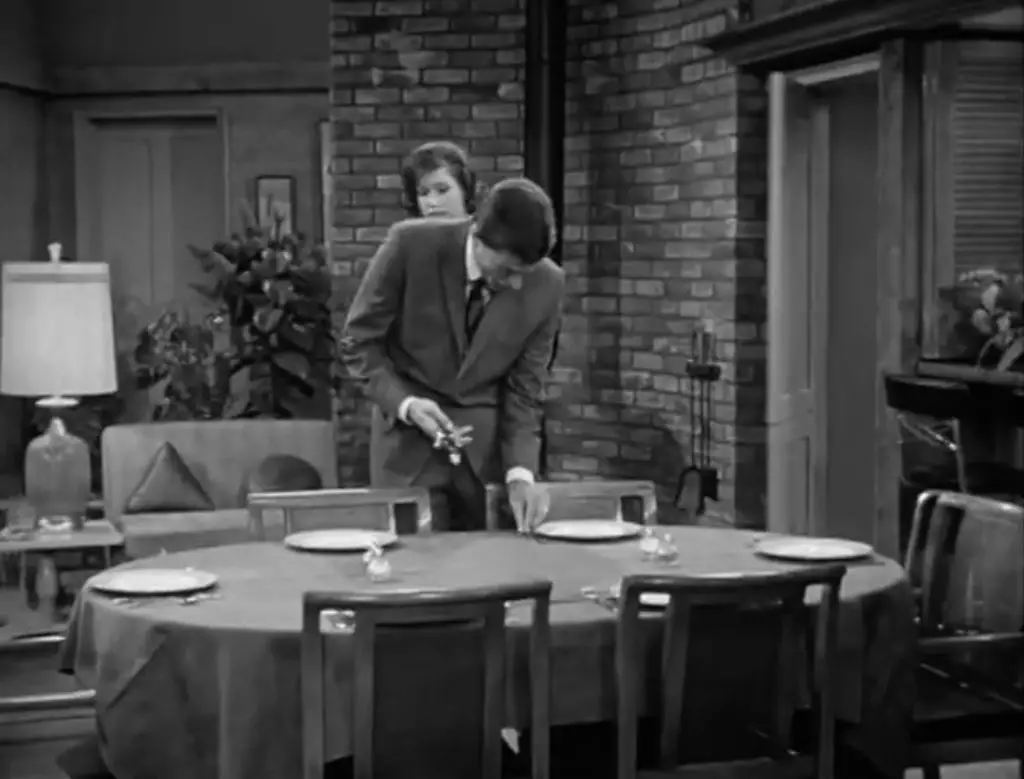
The bifold doors in the pass-through window, swinging kitchen door and contemporary dining set are obvious points of comparison, but subtle details, like the geometric pillows on the sofa carry the theme out fully.
A major element that has been relocated is the free-standing fireplace against the brick wall. In WandaVision this has been placed to the far left of the living room. Later episodes reveal a purpose behind this puzzling change. As Wanda’s “dream home” becomes more elaborate, and as the sitcoms move forward in time, the basic elements remain pretty much in the same location. To the far left is the fireplace, above that the entrance, across the entry to the right is a staircase (in future episodes), and to the right of that is the kitchen. When “reverse shots” are shown, the missing “fourth wall” of Wanda’s dream home includes access to the back yard.
The end credits continue the themes and styles of WandaVision’s celebration of the American sitcom. At the end of I Love Lucy, Lucy and Ricky were seen in a heart-shaped “window,” just before the credits rolled.
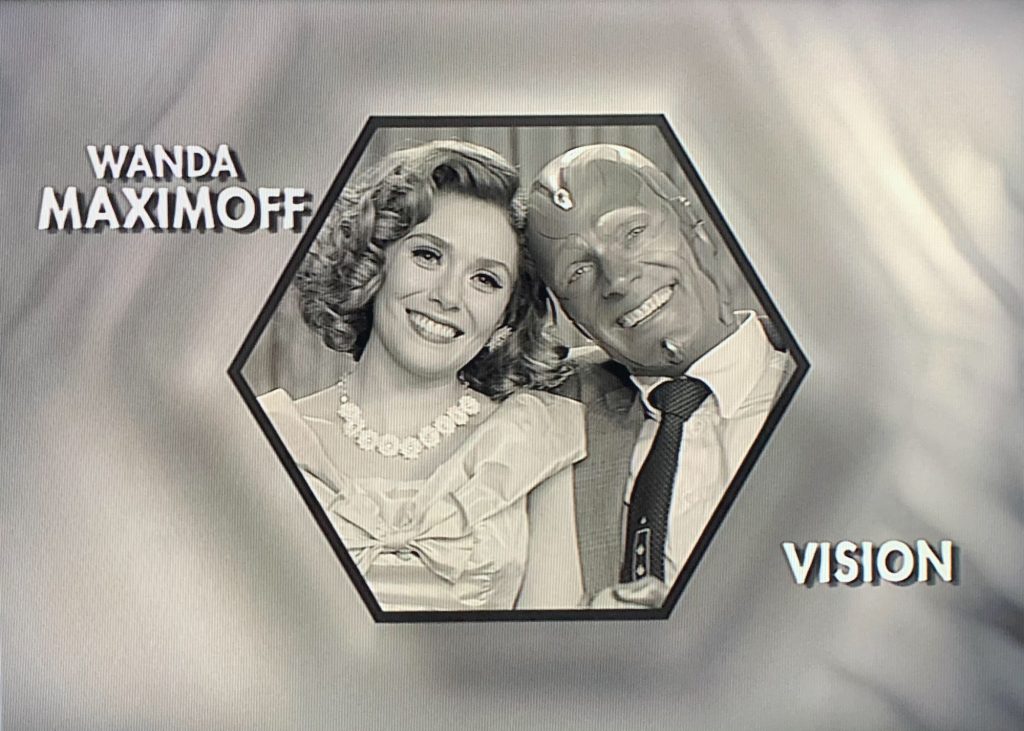
For Wanda and Vision, the “window” is a six-pointed hexagon. The rolling credits, however, are a meticulous mirror of the type seen in early episodes of I Love Lucy

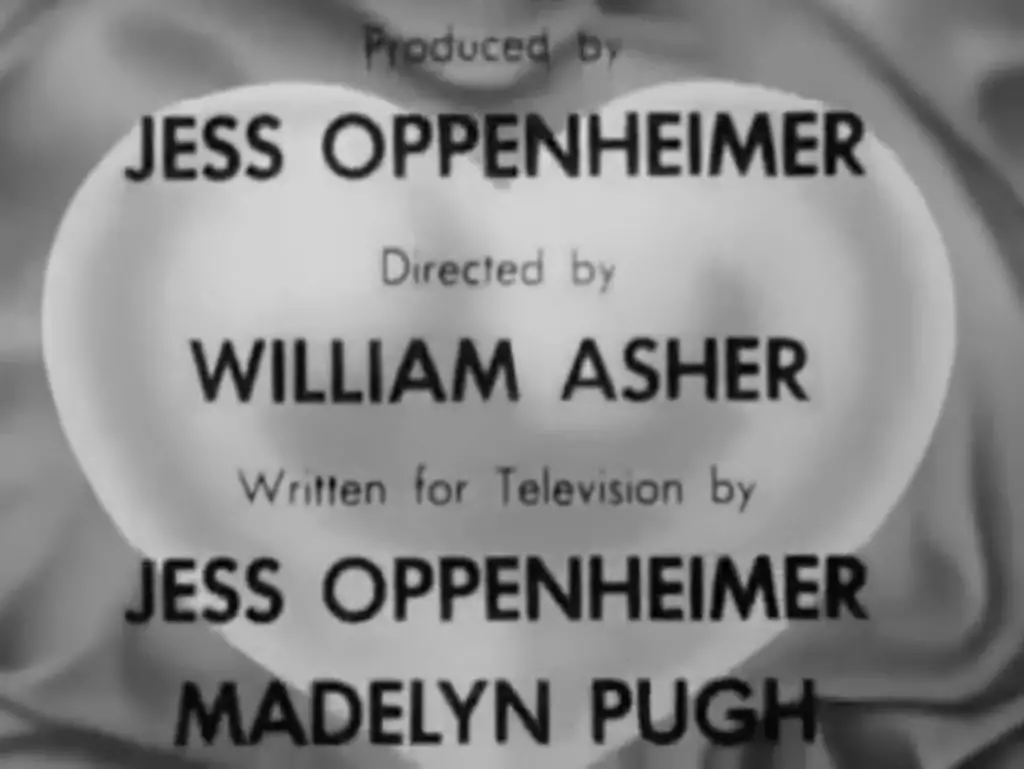
Names slowly scroll from the bottom to the top of the screen, a convention carried over to early television programs from film.

An unexpected element in the end credits of WandaVision’s first episode is a somewhat disorienting camera pull, along with a change in aspect ratio, revealing that this “show” is being watched by a contemporary viewer.
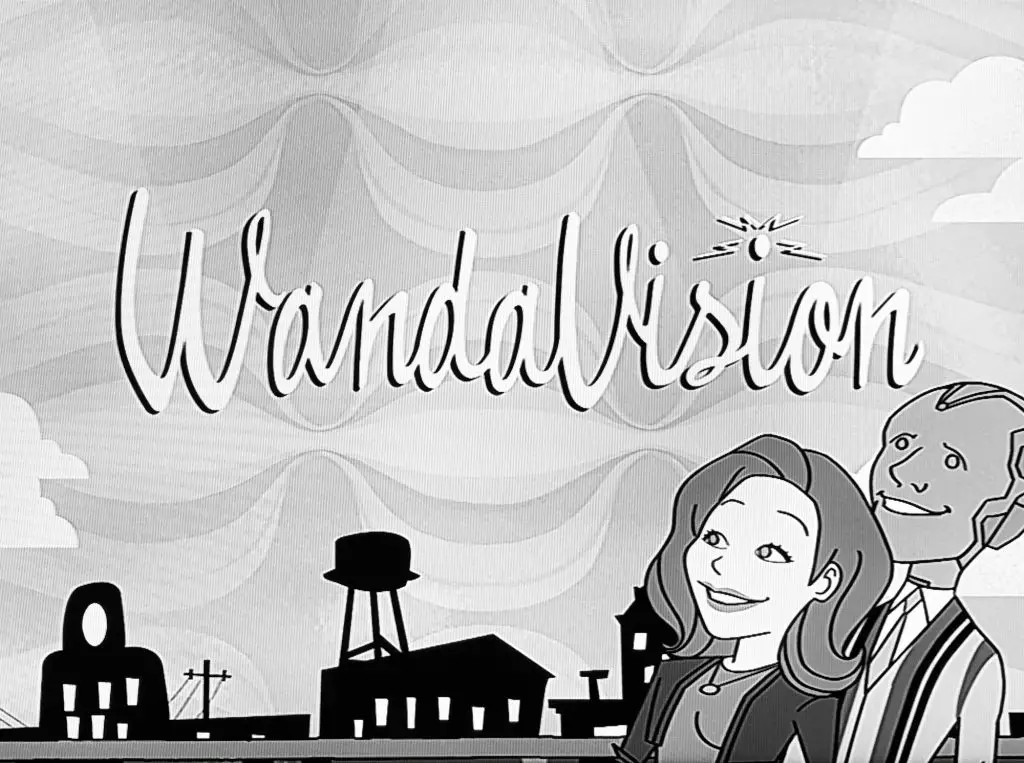
The animated opening for episode two is obviously inspired by Bewitched, a supernatural sitcom about a witch who willingly suppresses her powers for the man she loves. The theme music is reminiscent of another sitcom from about the same time, I Dream of Jeannie. It also featured an amusing animated opening, as well as a plot line featuring a woman with magical powers.

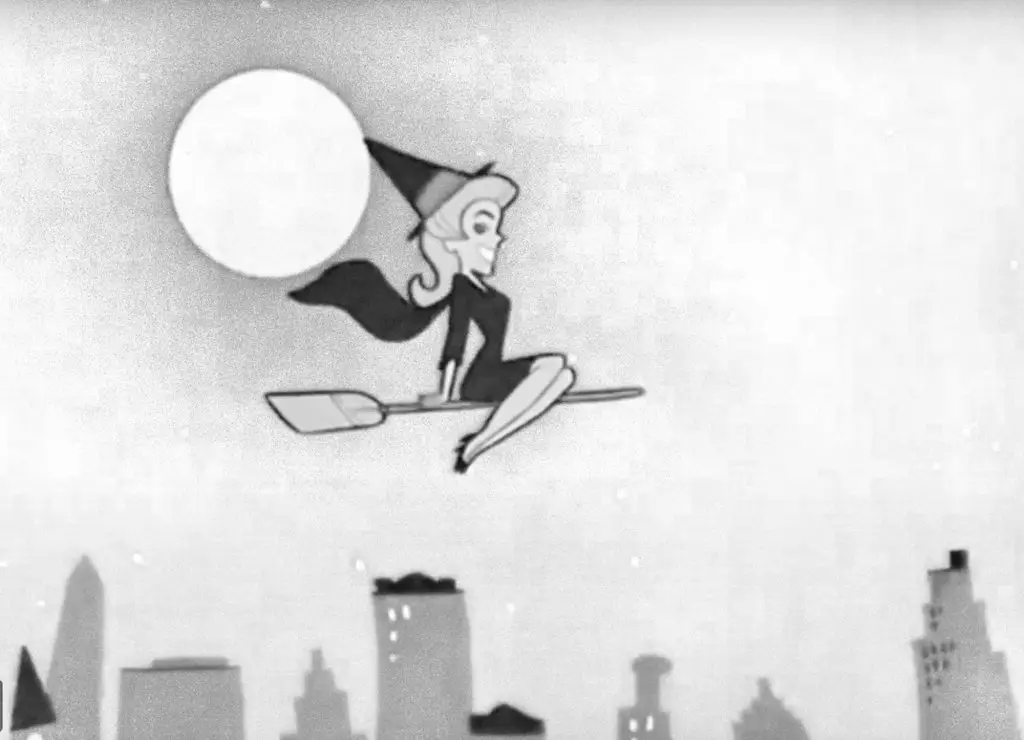
Images for WandaVision’s animated opening are derived directly from Bewitched. Wanda and Vision fly from behind the full moon, just as Samantha Stephens did, with the aid of her broomstick, of course.
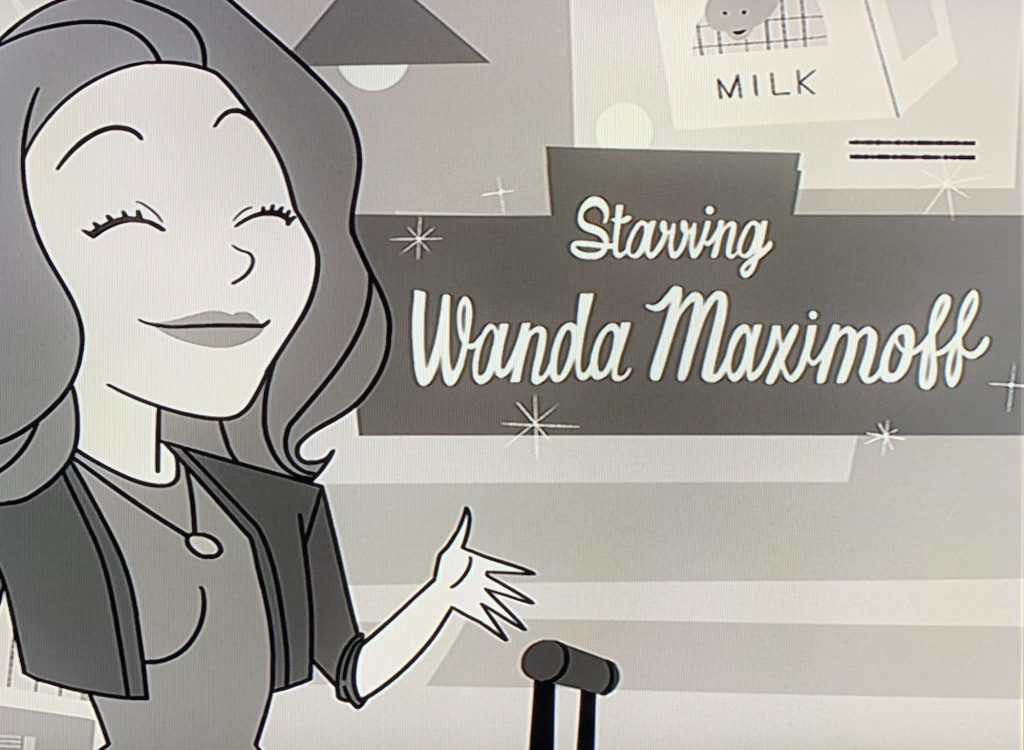
Wanda, meet…
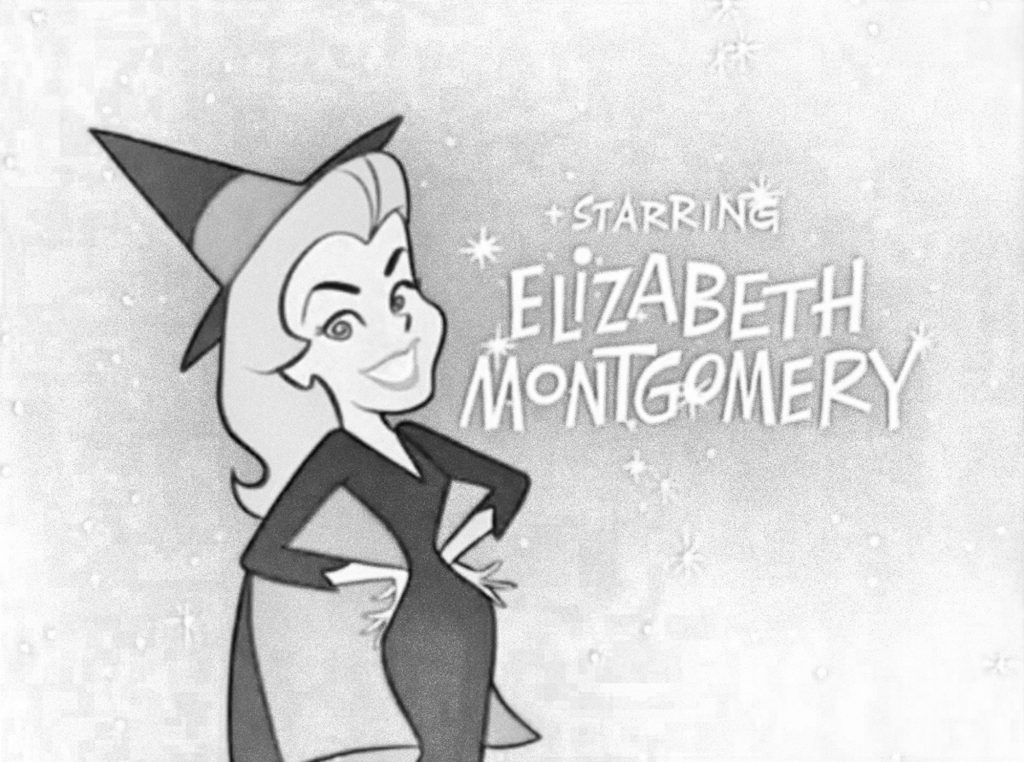
… Samantha.

Vision, meet…

… Darrin.
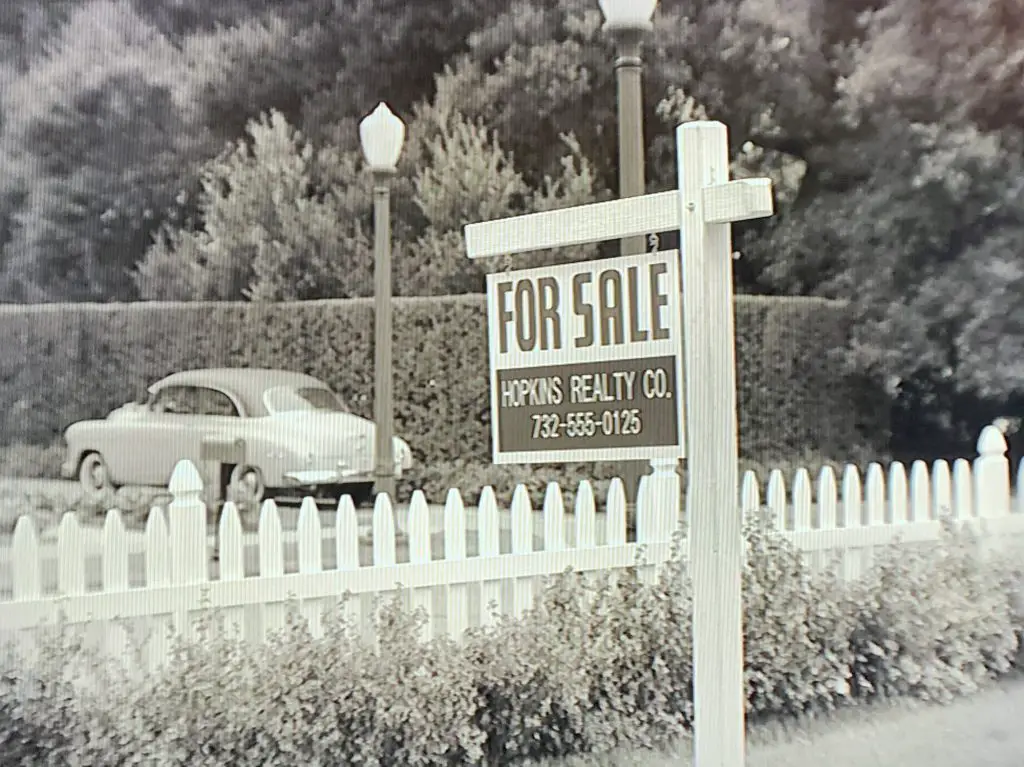
The “For Sale” sign in front of Wanda’s dream home should look familiar to sharp-eyed fans of Bewitched.

An identical sign, right down to the name “Hopkins Realty Co.” was posted in front of what would become the Stephen’s new home in the first episode of Bewitched, as Samantha and her mother Endora took a tour.
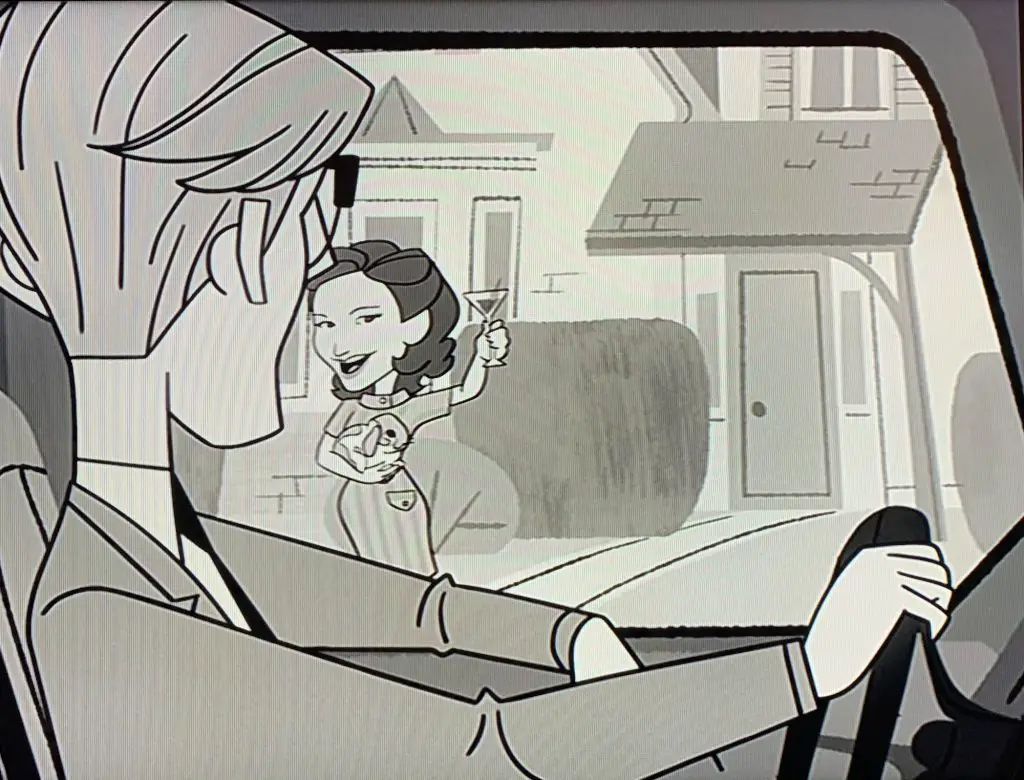
The Stephen’s house makes a fleeting cameo appearance in the animated opening, by the way. As Vision drives up the street of waving neighbors, the last one we see is Agnes, standing in front of the last house on the corner. It looks like Agnes is living in a house once occupied by a famous sitcom witch!
Episode two also features an amusing “teaser scene” before that opening credit sequence. It is set in the master bedroom, where Vision and Wanda are ensconced in their twin beds.

It is widely believed that every sitcom couple in the 1950s and 60s slept in twin beds, at the insistence of prudish TV network censors. This is not entirely true, but there were certainly some famous examples.

Lucy and Ricky (I Love Lucy) had twin beds.
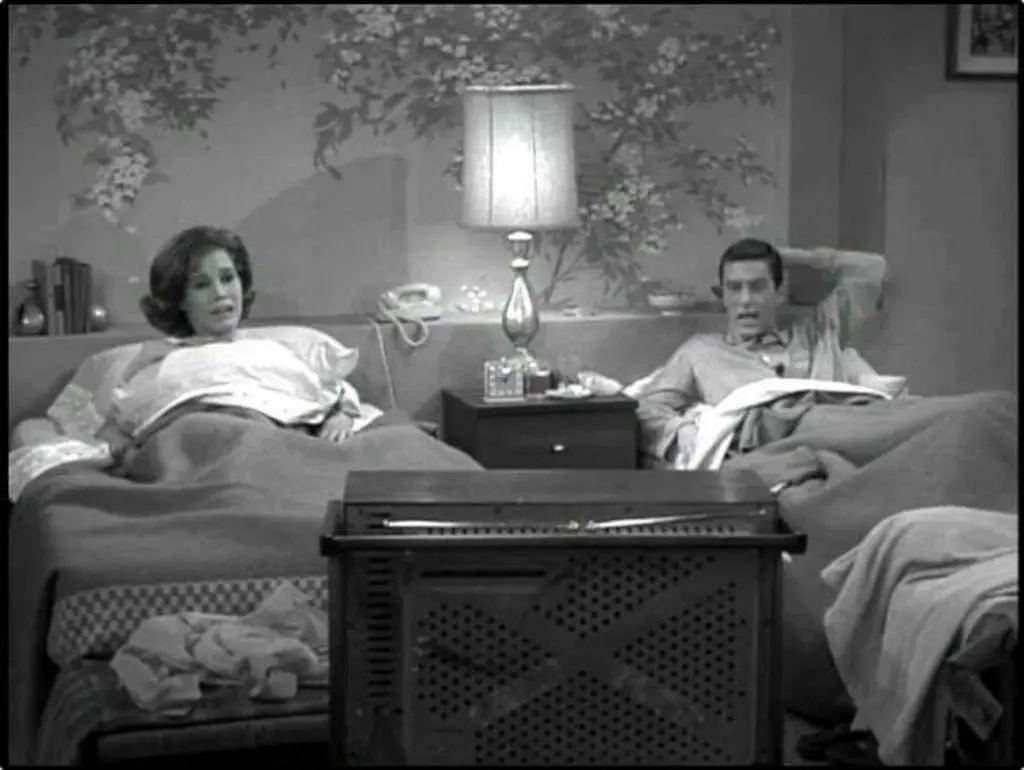
Rob and Laura (The Dick Van Dyke Show) did, too.

But Darrin and Samantha (Bewitched) shared a double bed.

So it only makes sense that by the end of this scene, Vision and Wanda do, too.
Within episode two there are, again, direct visual references to the sitcom home of Samantha Stephens, but not necessarily put together in exactly the same way.
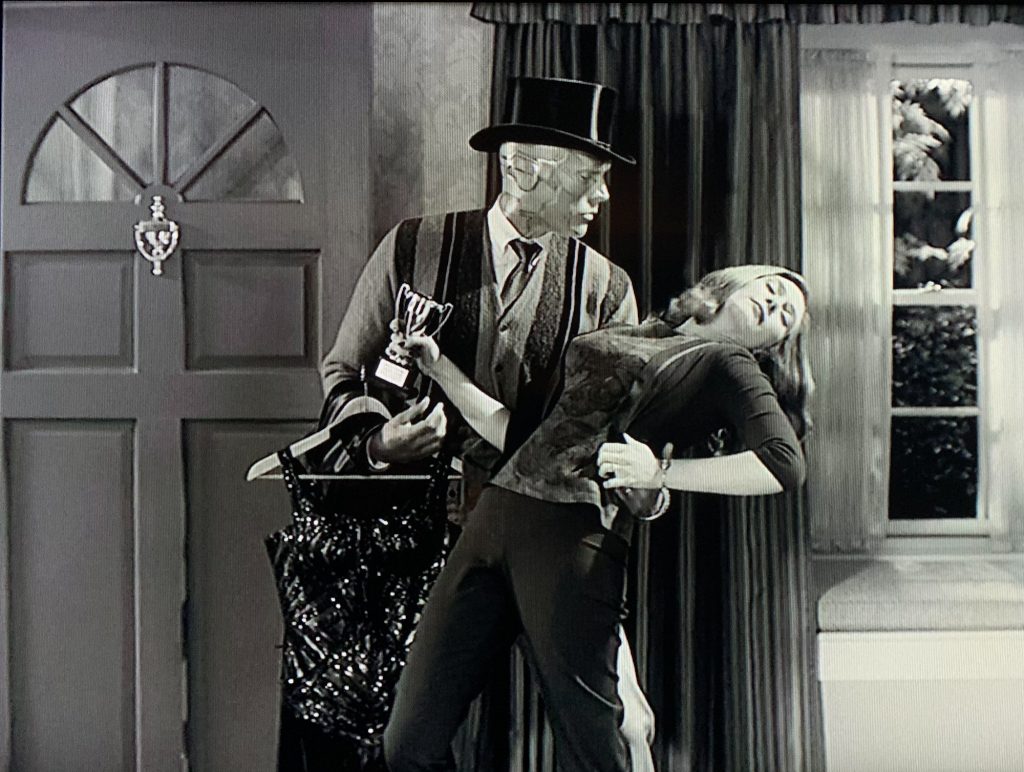

The front door is certainly an exact match. (Wanda and Vision above, Samantha and nosy neighbor Gladys below.)
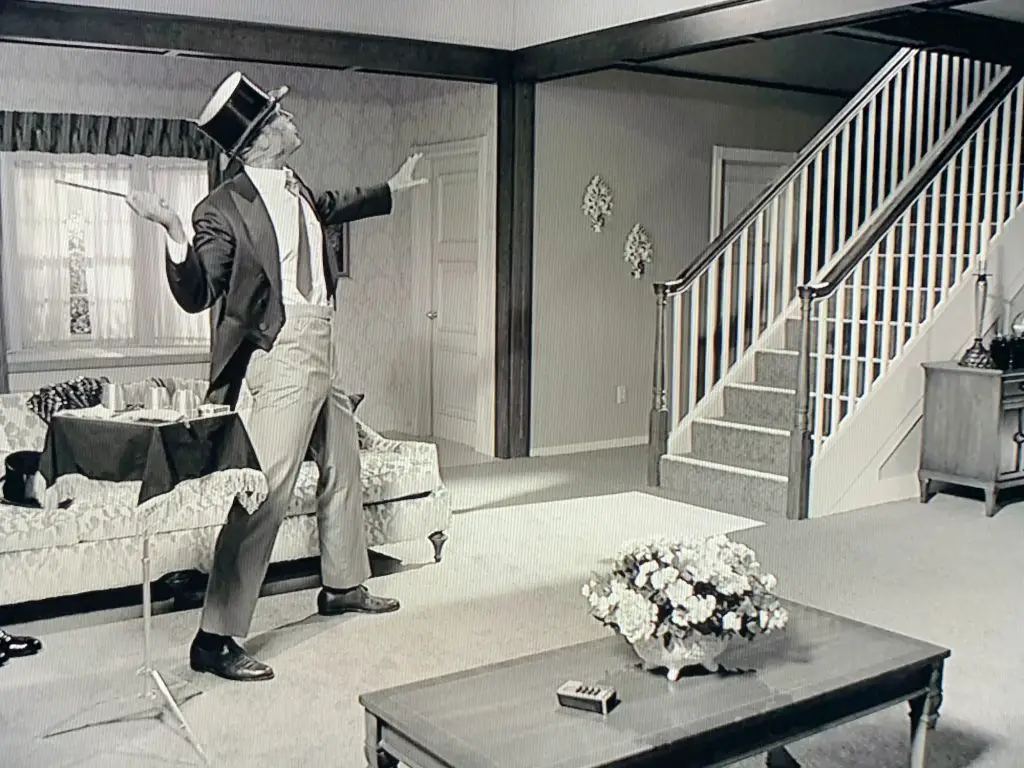
The most notable element is the dramatic, freestanding staircase leading to Wanda’s new second floor.

While the staircase in Bewitched made a short turn at the landing, there is no mistaking the provenance. To the right can be seen the Stephens’ dining room and kitchen, featuring mid-century versions of colonial furniture.

And that is just what Wanda has, as well.

In episode two, Wanda can move all the way around her home, just as Samantha could, offering us a glimpse of the doors leading to the backyard.
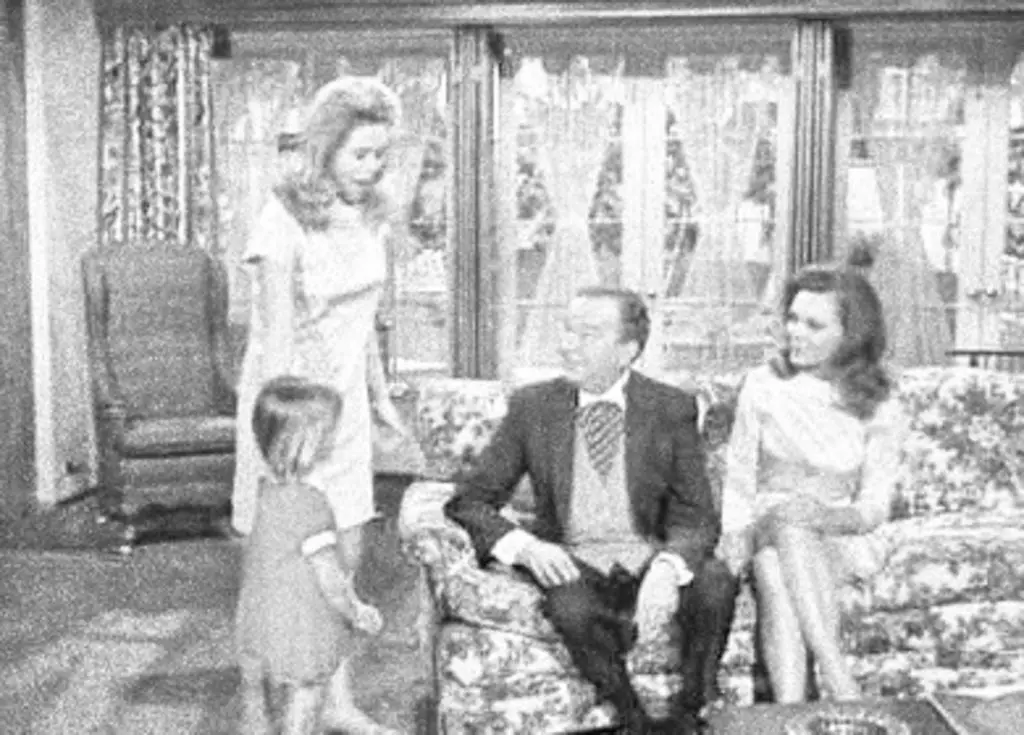
The Stephens had an identical arrangement, right down to the shirred lace draperies pulled into hourglass shape.
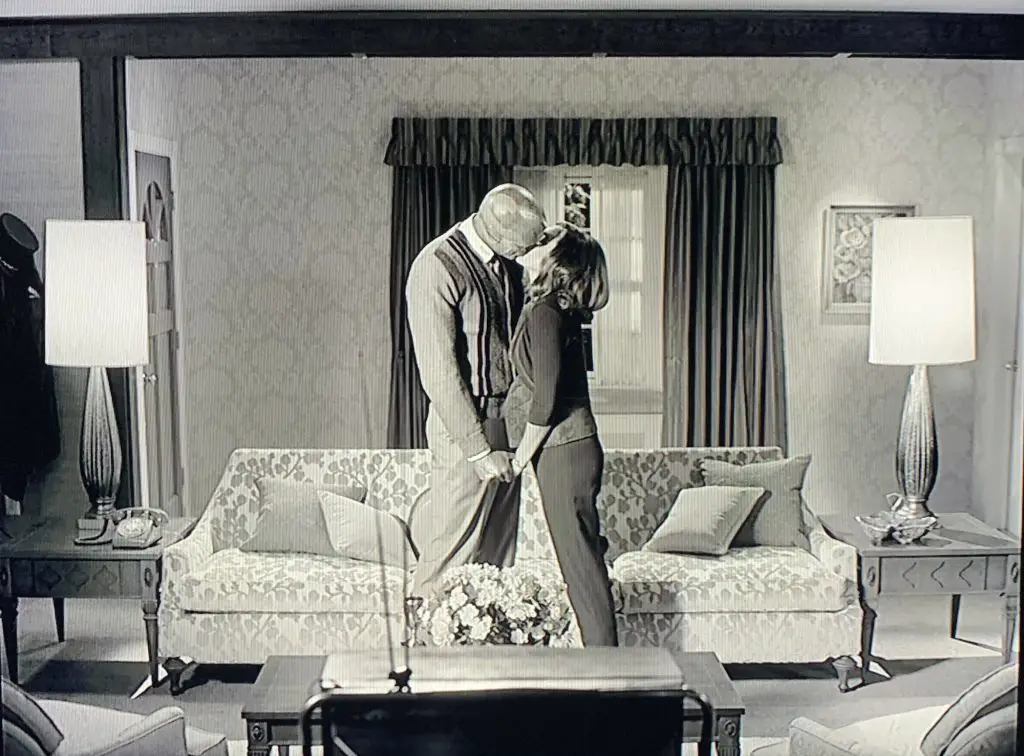

Notable in episode two of WandaVision was the appearance of full color. Bewitched also made the switch to full color, though not quite so dramatically. From 1964 to 1966 it aired in black and white, and from the fall of 1966 to the end of the series in 1972 it was in color.

Vision notes the change as it sweeps across the living room.

And here is a fireplace wall of the living room in Bewitched, as it appeared in color.

Throughout the episode Vision is wearing a rather distinctive sweater. He looks right at home in it, which is no surprise.

It looks a lot like a signature “Dick Van Dyke” sweater, available in finer stores everywhere during the run of The Dick Van Dyke Show.

The end of episode two features another hexagonal window, this time in full color. That hexagon is used as something of a motif in WandaVision. It even turned up in very subtle form in the animated opening.

The twinkling “stars” around the moon are not randomly tossed across the night sky in WandaVision.

No, these stars are more like a set of six glittering gems, set in precise formation. Connect the dots, and you’ll have a hexagon.
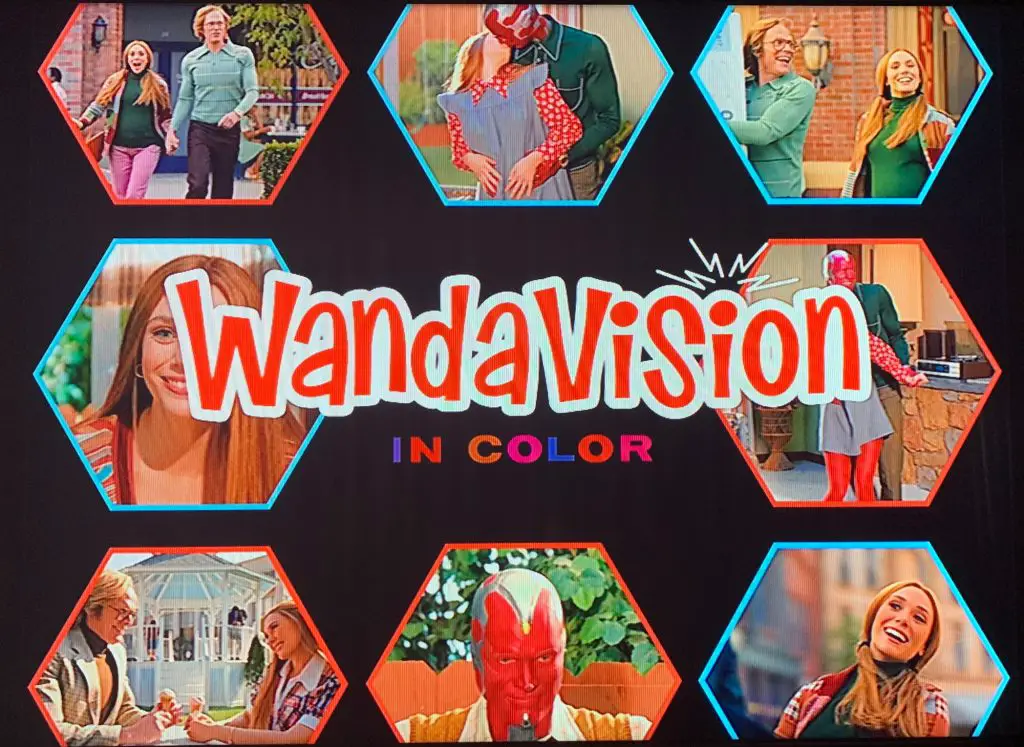
There are hexagons galore in the colorful opening of episode three of WandaVision. If there was any doubt the words “IN COLOR” are part of the title. The sitcom provenance of this title card is as plain as can be.
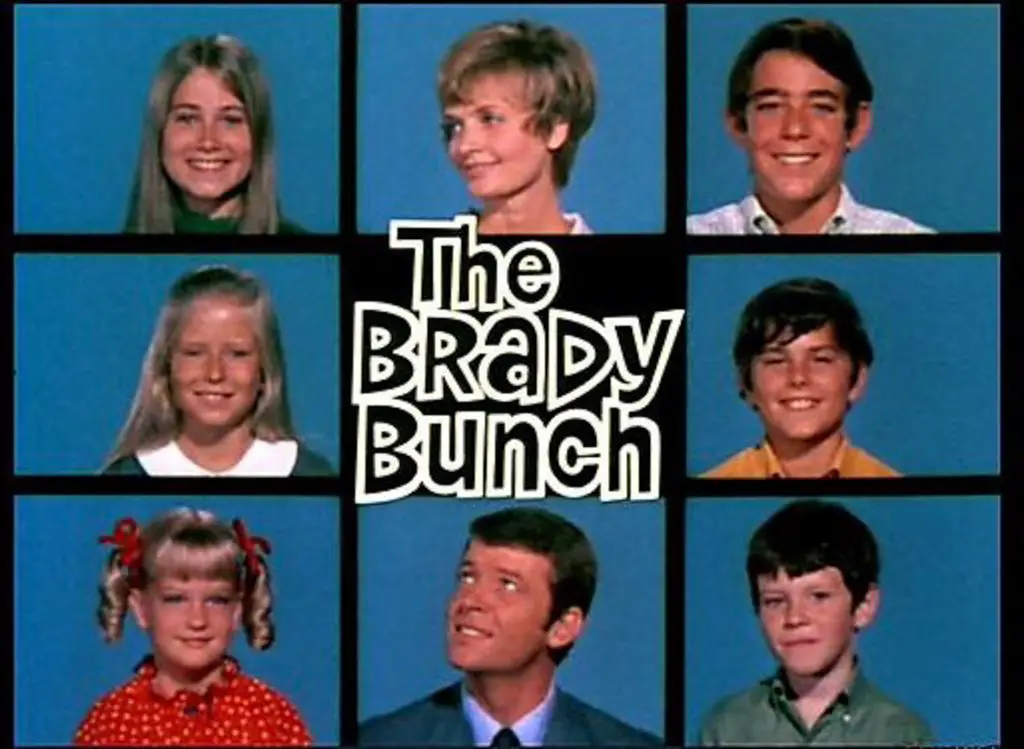
This is how the Brady Bunch began every episode of their series, though they are definitely a lot more “square.”

Wanda gets the big window and all the smaller ones.

Carol Brady shares her screen with her three “lovely girls” (the youngest one, incidentally, in curls).
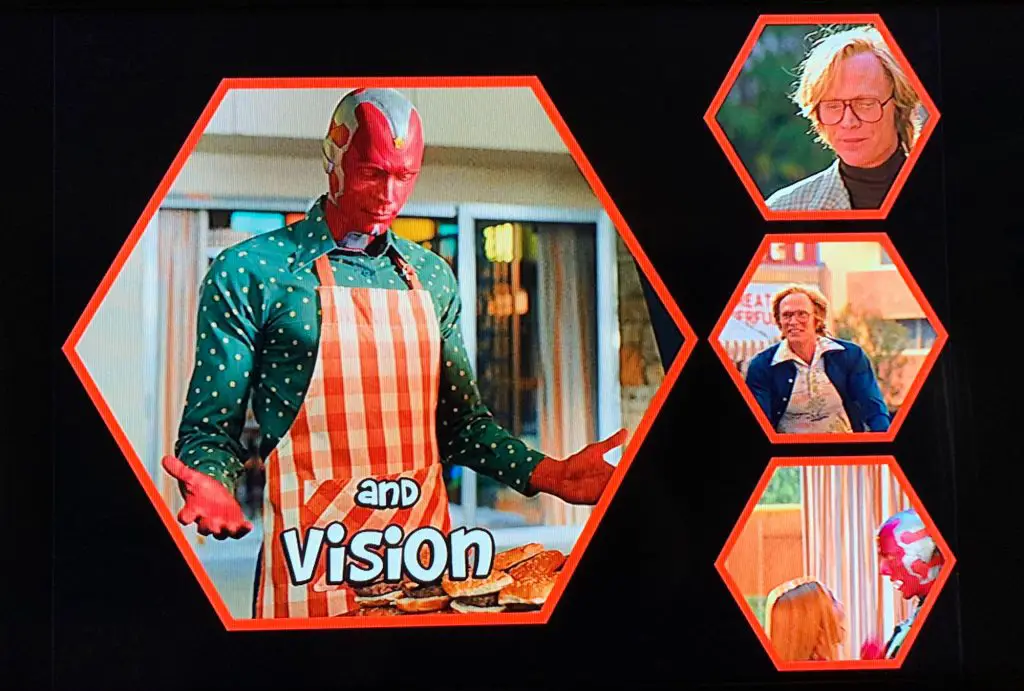
Vision is also a solo act. (Can that guy cook!)
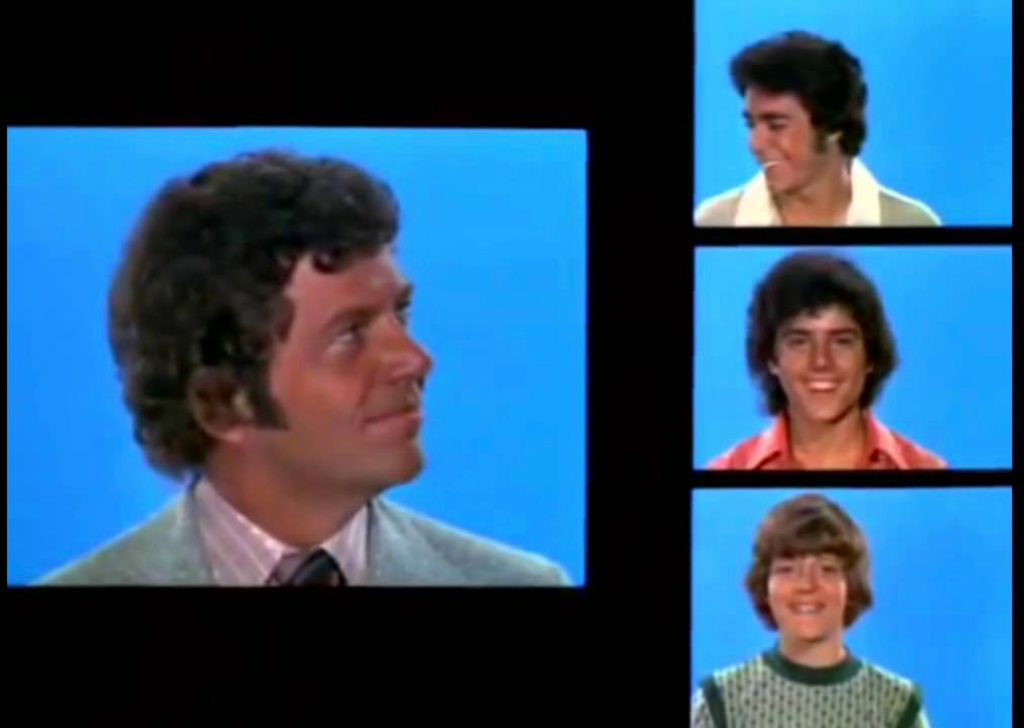
Mike Brady and the boys. They were four men living all together, but when you come down to it, they were all alone.
While the Brady Bunch was the biggest visual influence in this episode, elements from other sitcoms of the same era can also be seen, as well as heard. The theme song is very reminiscent of “Get Happy” from The Partridge Family. And the extended montage of Wanda and Vision cavorting around town recalled another memorable series.

Lest there be any doubt, this rainbow hued image of stacked titles actually opened the episode.
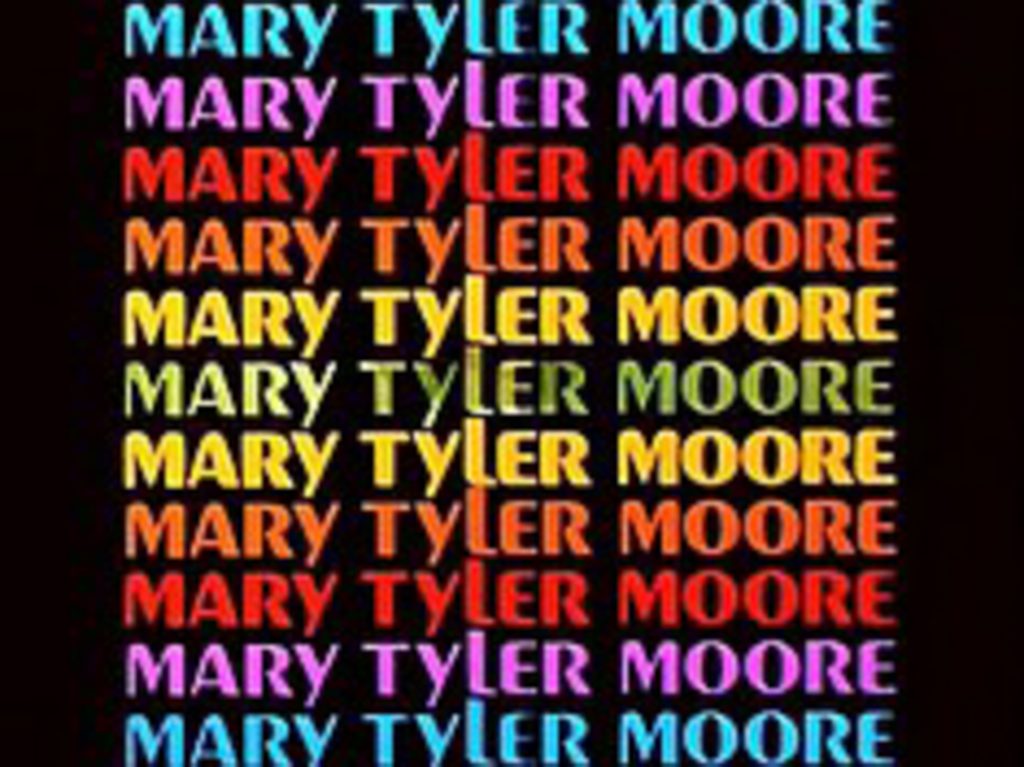
And here is that same rainbow stack, seen in the opening titles of The Mary Tyler Moore Show.

Wanda is out and about, enjoying a day in Westview.

Mary Richards, on the other hand, is enjoying her single life in Minneapolis.
One major difference in these two sequences is that Mary Tyler Moore went on location for her opening titles. Wanda stayed safely on the backlot, specifically the Disney Studio’s Golden Oak Ranch Business District.

Wanda and Vision enjoy ice cream in front of the town gazebo.
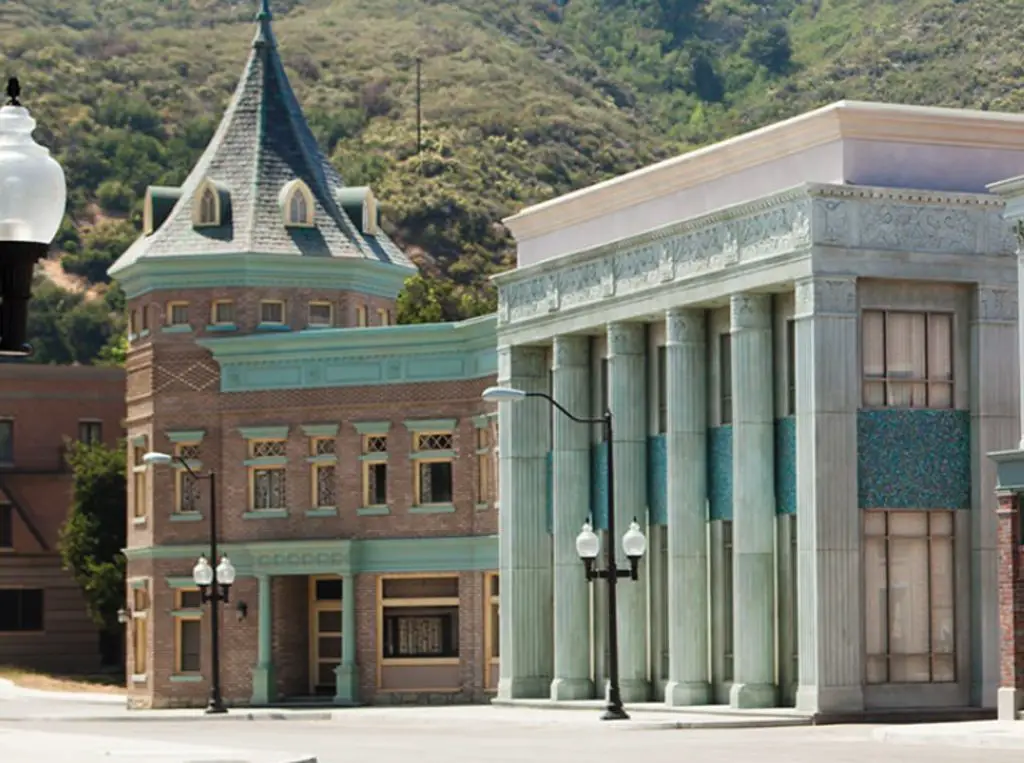
That gazebo is blocking the view of these backlot buildings. The tower to the left and the Santa Clarita Mountains have been removed through digital wizardry. (No sign of that water tower this week.)

Vision and Wanda bike past an old-fashioned movie theater.
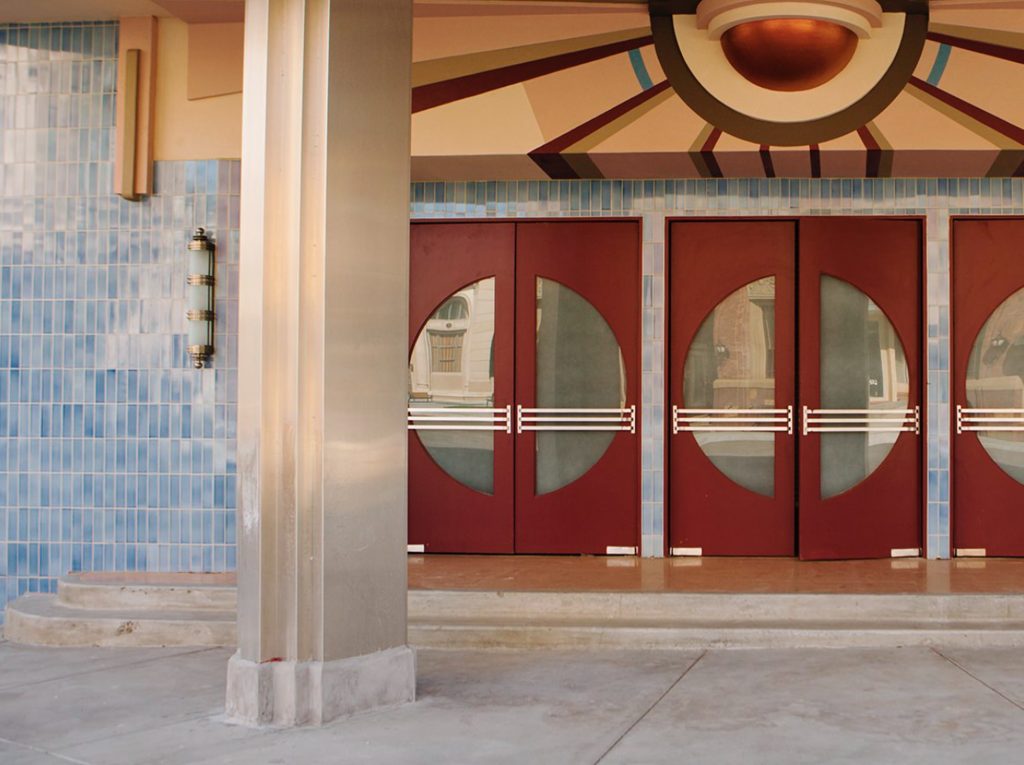
The doors and distinctive light fixtures match this theater on the Disney lot.
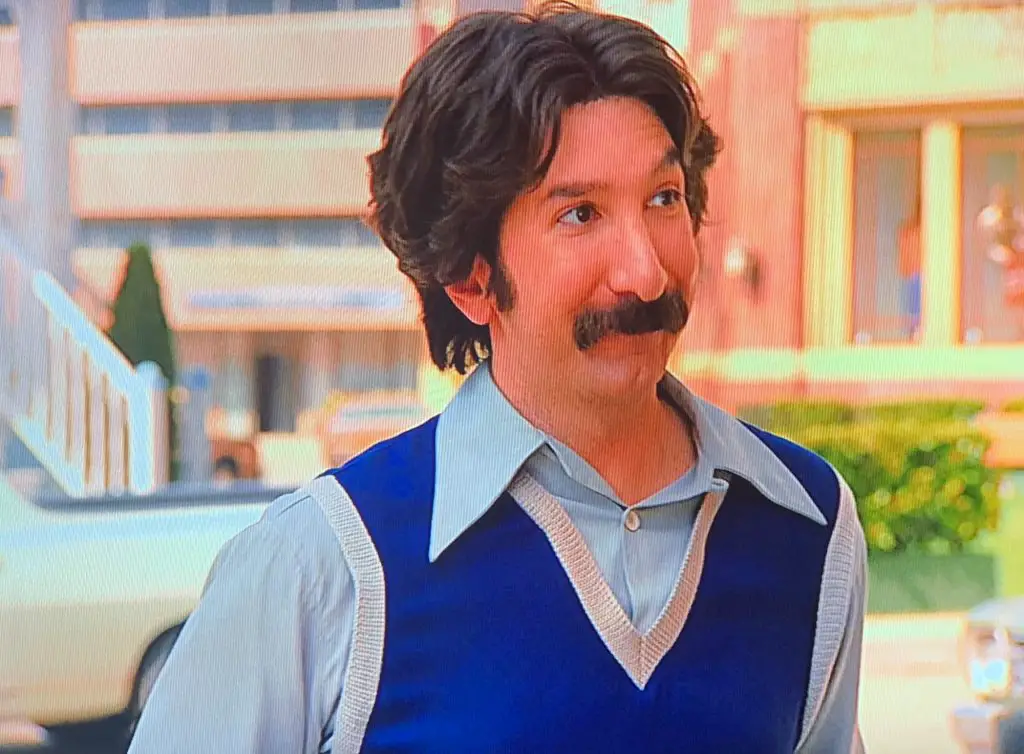
Down the street behind neighbor Phil can be seen a distinctive building with horizontal bands of brick.
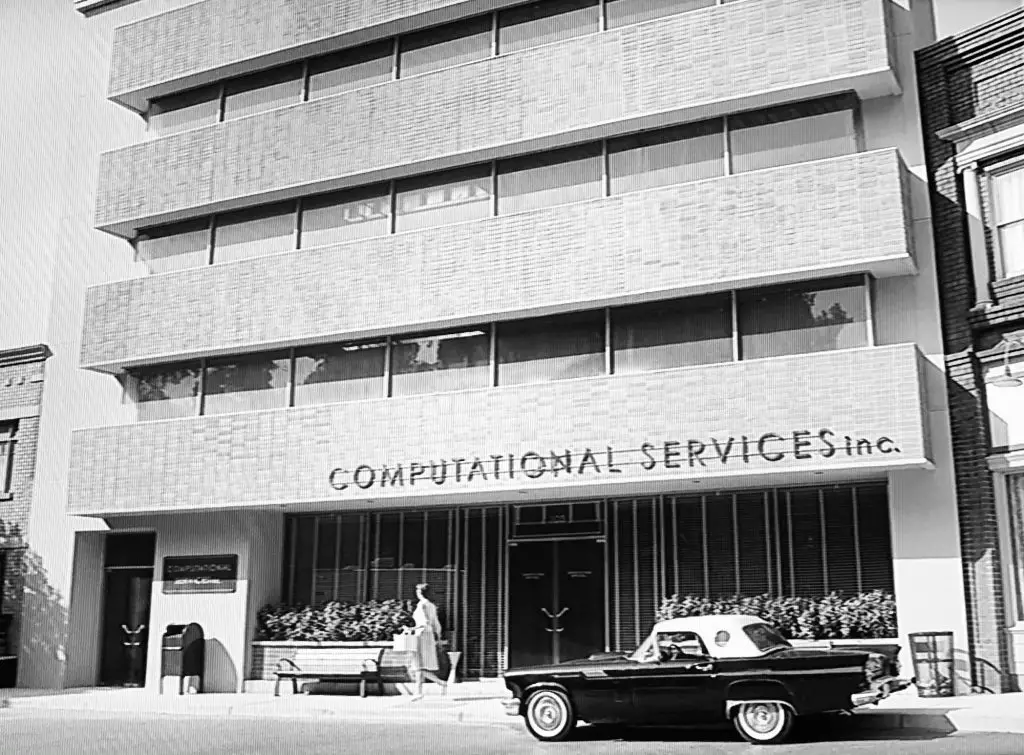
It’s Vision’s office, Computational Services, seen in the first episode of WandaVision.

Vision and Wanda do some shopping at Wentworth’s, which has been given its own colorful makeover.
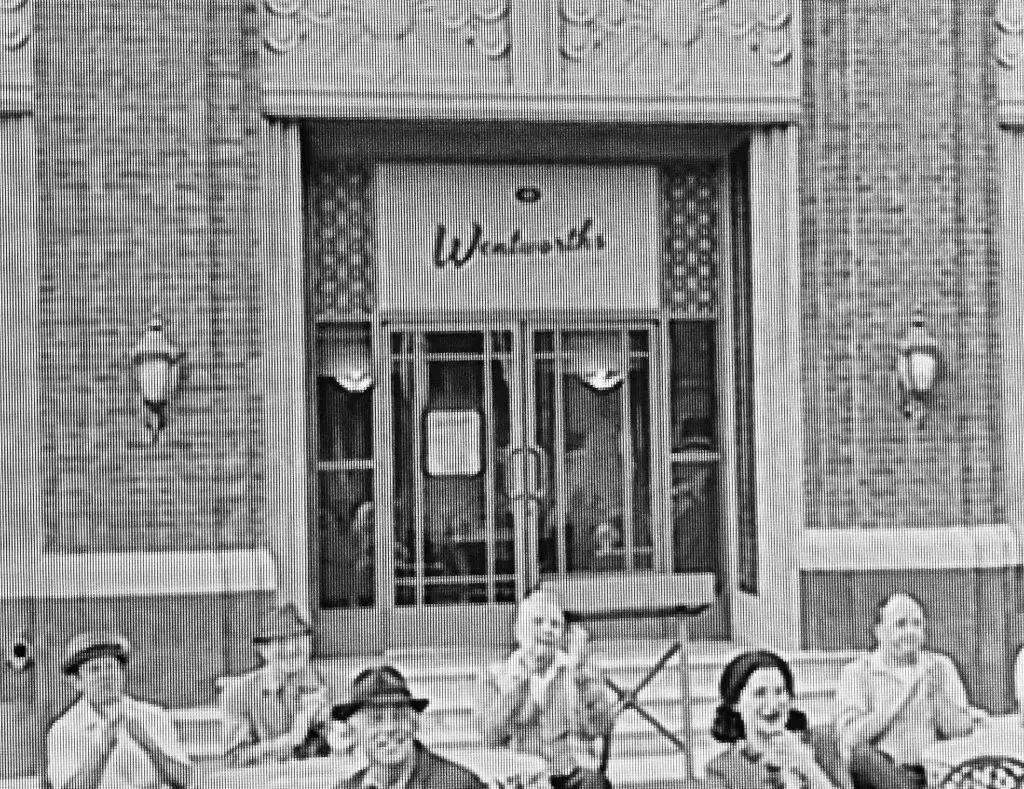
Here is Westview’s leading department store as seen in episode two.
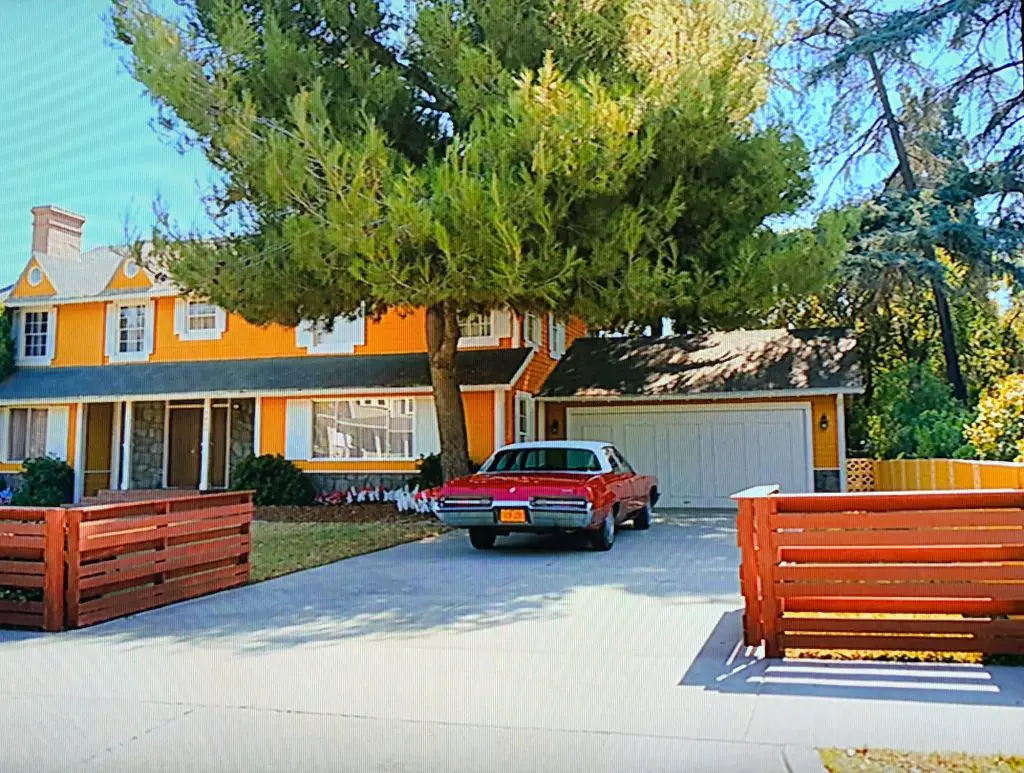
Wanda’s dream home, on the other hand, can still be found at the Warner Ranch in the San Fernando Valley. Brighter colors and a sleek new car reflect the groovy 1970s setting for the episode.
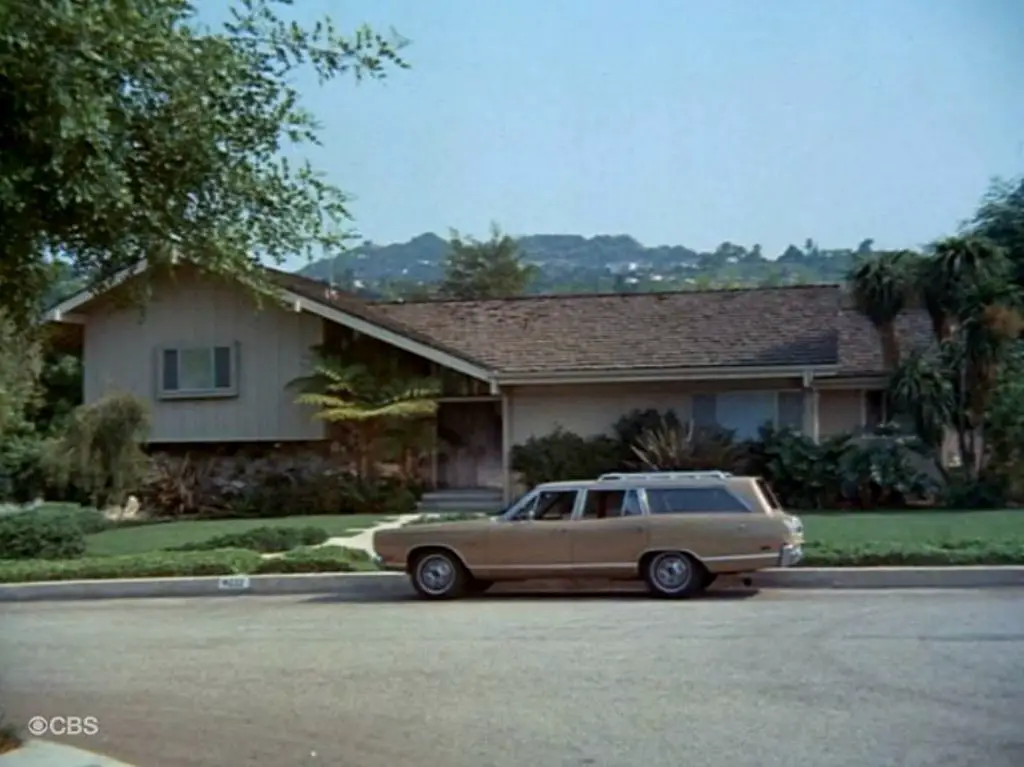
The Brady Bunch also had a house in the “real” world, although none of the cast ever actually shot any scenes there. The second floor window was also added by the production company, as this residence in Los Angeles had no second floor.

There is no mistaking Wanda’s new staircase. Even though it is reversed from the direction it was seen in The Brady Bunch, it is the same distinctive design.

Here is that staircase as it appeared in the original series.

Maintaining the same basic layout, Wanda’s entry features a heavy rock wall with clerestory windows.

The Brady’s had double doors, oriented in a different direction. The heavy stone and brick facings on the landing are the same, though.

Looking back at the entry to Wanda’s house, there is something confusing about matching it to the exterior. Inside, the front door appears to be directly adjacent to an exterior wall, yet in the view from the front, that front door is set in the middle of the house, with rooms on each side.

Compounding the confusion is the door to the nursery, and the view out the nursery window. According to this, the room extends out of the front of the house, and has a view toward the front porch and door.
This kind of “geographic” confusion is actually a part of the history of sitcoms. Sharp eyed viewers can often spot mismatched interior and exteriors, as well as noting doors, windows, and whole rooms that mysteriously shift and change between episodes.
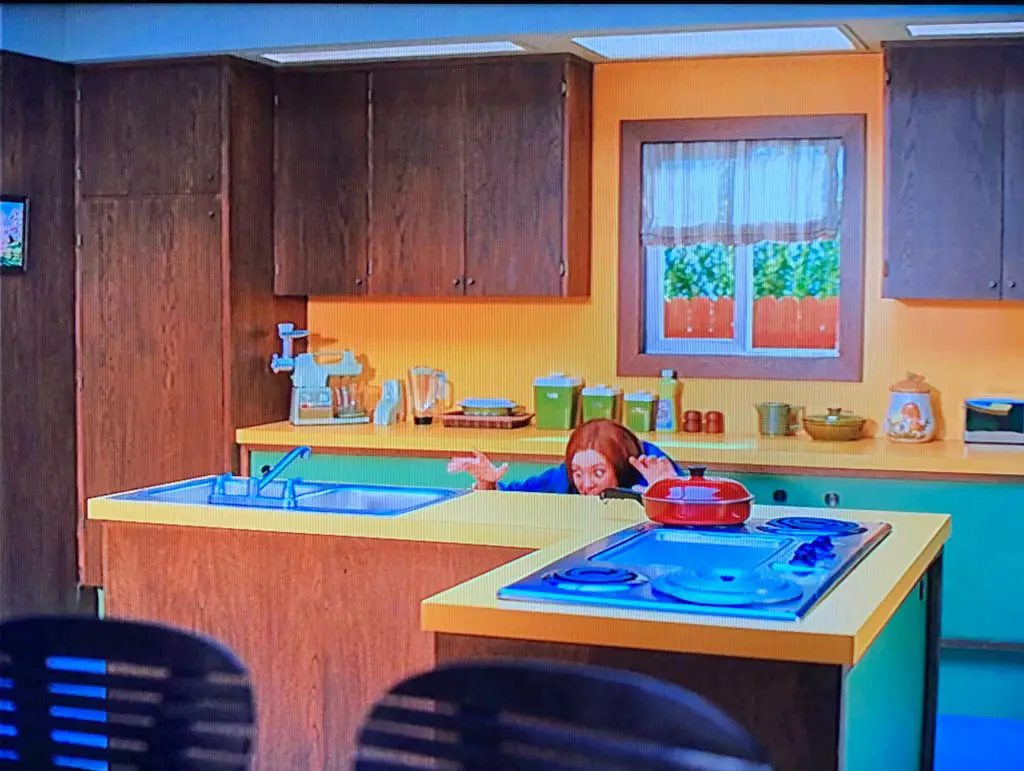
Wanda’s kitchen is a symphony of burnt orange, avocado, and dark wood.

The Brady kitchen features the same angled work island, albeit without the exterior window.

The property master and set decorator for WandaVision were so proud of this avocado green Oster mixer they displayed it with every attachment.

Spotting props can be fun! Note the tapered curio cabinet in Wanda’s living room.

And there it is again, in the corner of the Brady’s living room.
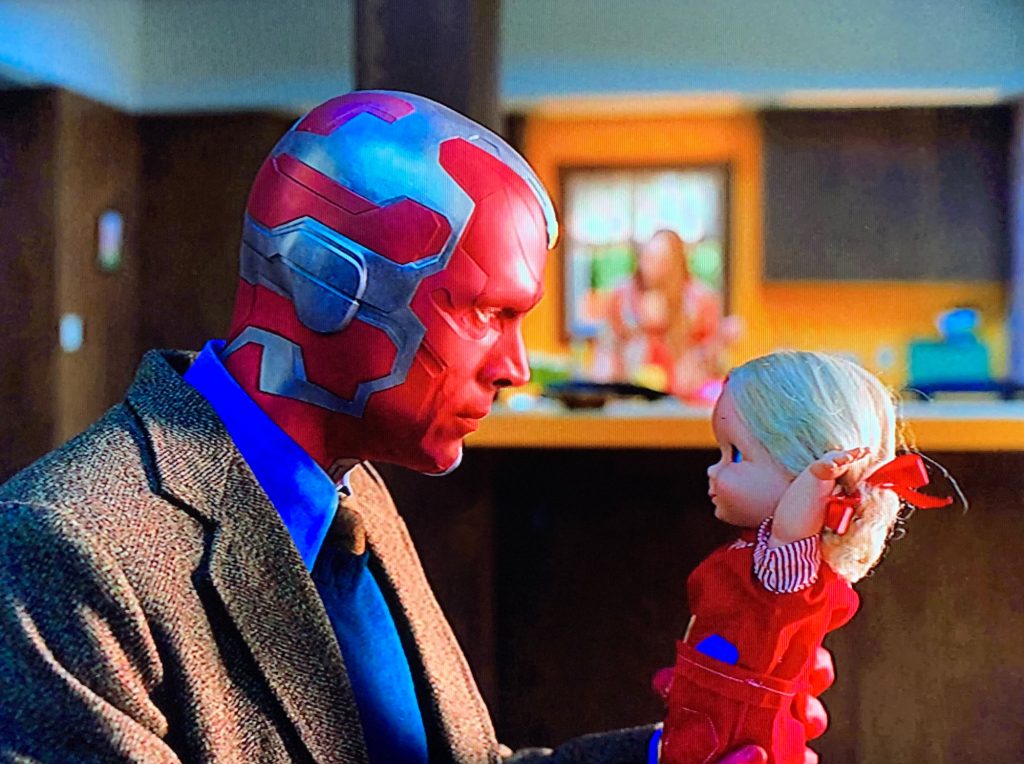
Another item fans of The Brady Bunch cannot have missed is the doll Vision uses to hone his diapering skills.

It certainly looks a lot like Kitty Karry-All, Cindy Brady’s beloved doll.
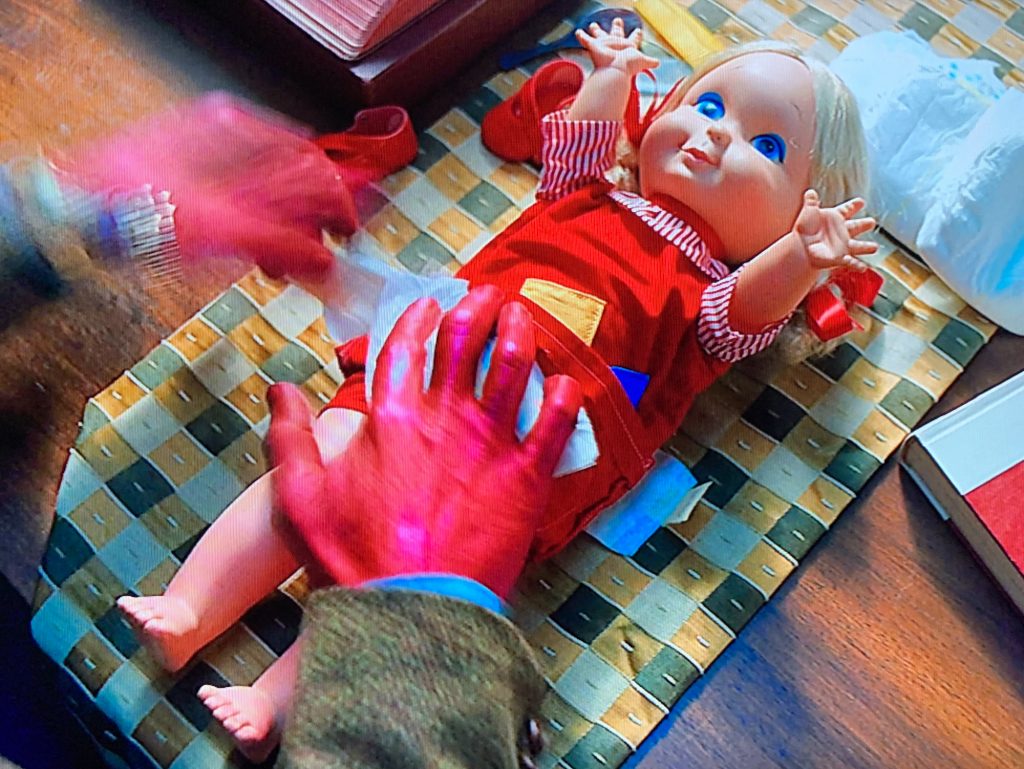
It is possible to get a closer look at Kitty Karry-All, despite Vision’s swiftly moving hands.

If there were any doubts, here she is, in all her multi-pocketed glory.

Vision also managed to find a salmon colored baby book, a colorful addition to their colorful home.

As it turns out, the book is real, a publication of Better Homes and Gardens.
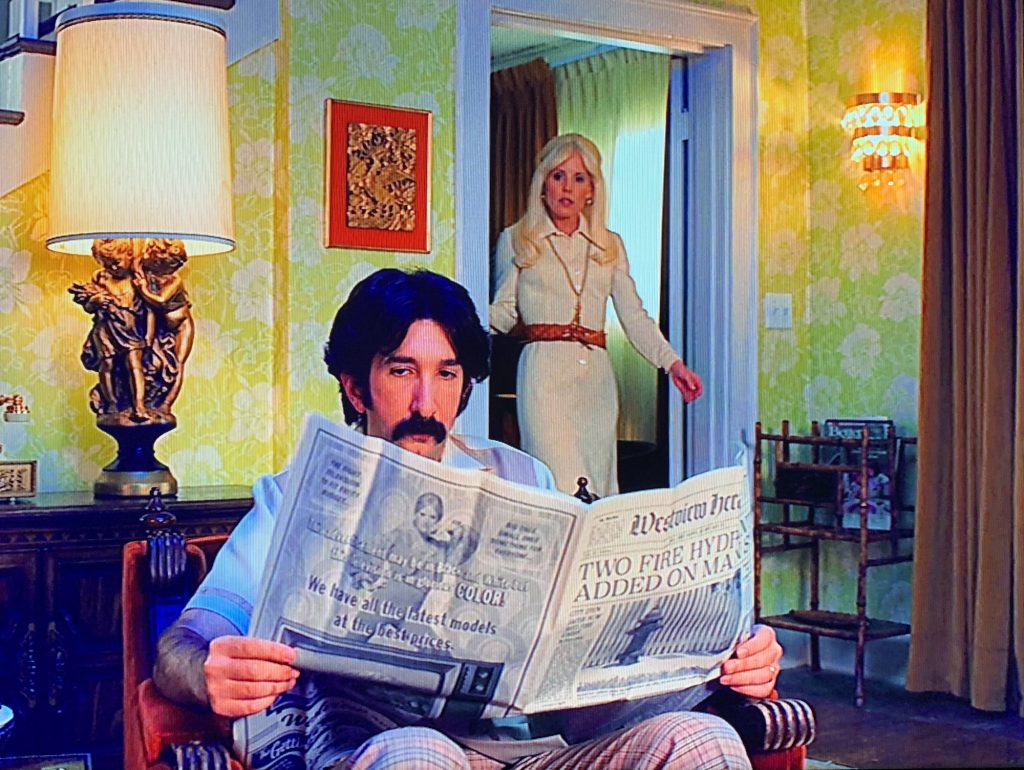
Episode three also offers us our first look at Phil and Dottie’s neighboring home. What a coincidence; they have a copy of Better Homes and Gardens in their magazine rack. According to the banner headline on The Westview Herald, two fire hydrants have been added to Main Street! It is also possible to read the text for the full page advertisement on the last page: “This advertisement may be in black and white, but the television is in glorious COLOR!” This is something Wanda may have been longing for since episode one.
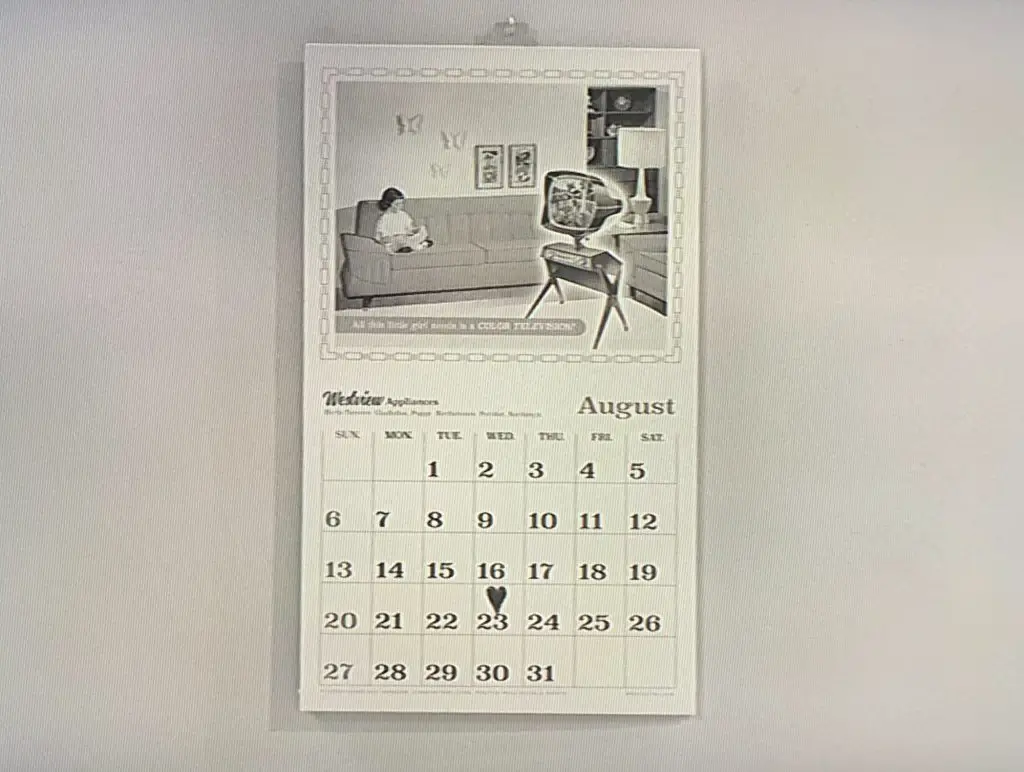
The calendar on the kitchen wall in Wanda’s original dream home was also from a Westview appliance store. The text on the illustration reads: “All this little girl needs is a COLOR TELEVISION.”

When the lights go out, Phil and Dottie manage to violate one of the cardinal rules for television performers: Never look directly into the camera.
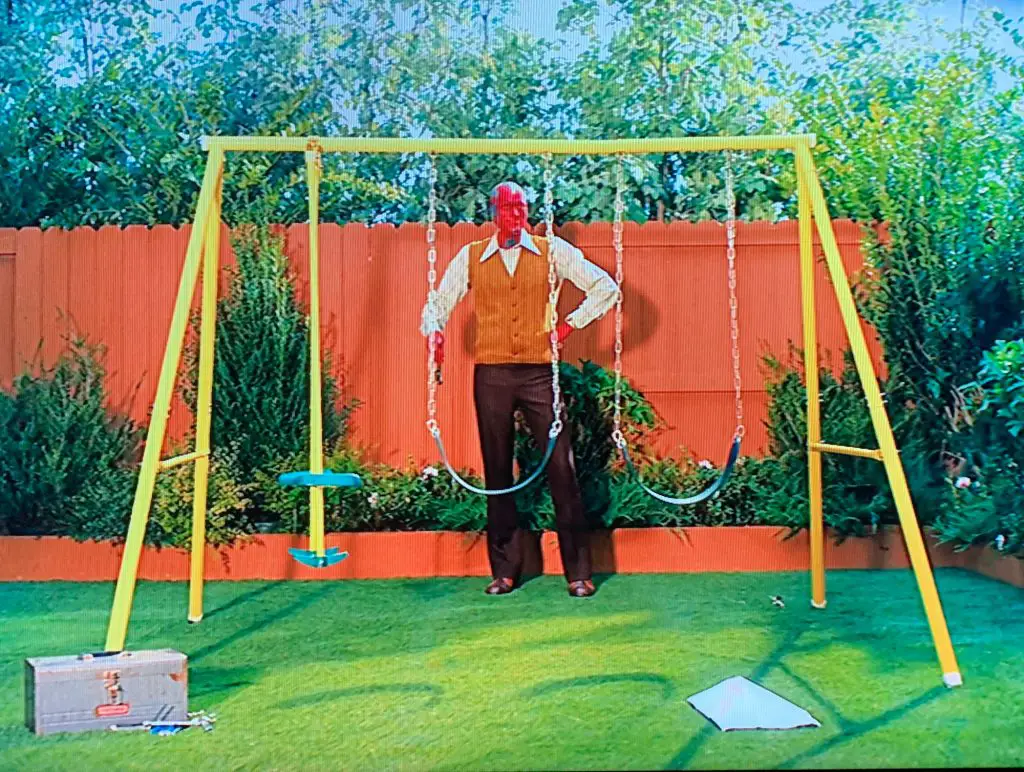
Episode three also offers our first look at Wanda and Vision’s backyard. There is something oddly artificial looking about it, however.
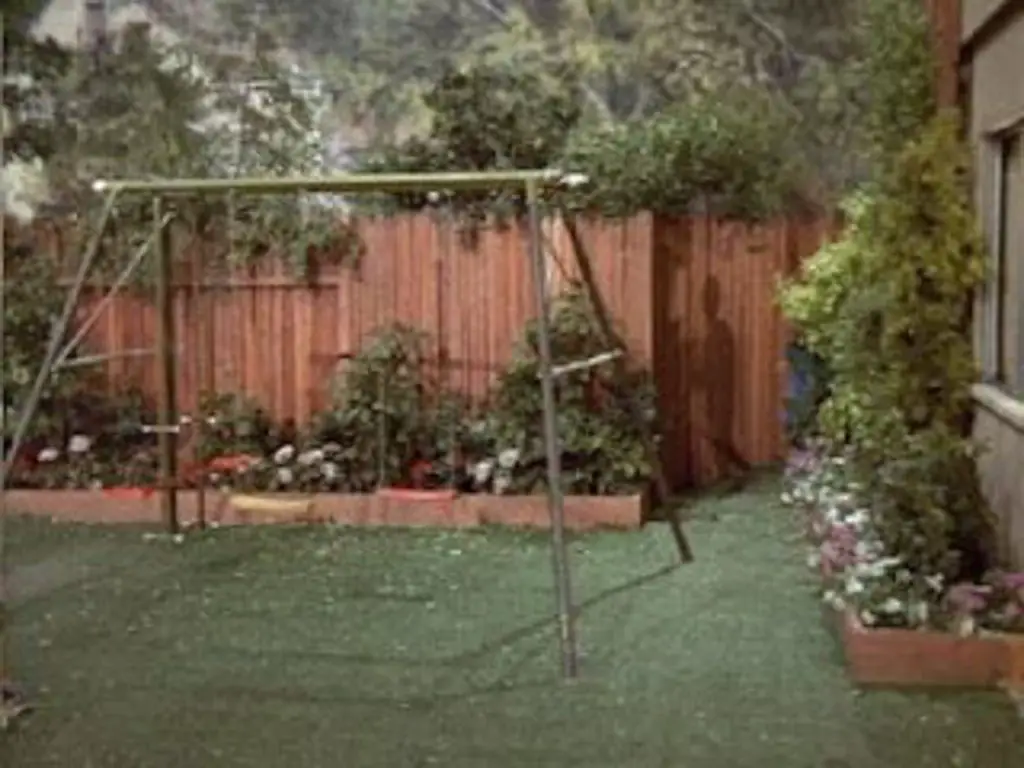
Turns out it’s no more artificial looking than the backyard seen in The Brady Bunch. Oddly, the Bradys home, inside and out, existed solely on soundstages. During some of the scenes where the kids are playing in the backyard you can see them accidentally kick up the astro-turf.

Bringing this full circle, as Vision greets the neighbors in his front yard, the entire house is now on a soundstage, with an obviously painted backdrop and artificial trees.

And even the neighbor’s house has turned into a meticulously painted backdrop, displaying some skillful forced perspective. Agnes and Herb look right at home— although it appears that Herb is trying to cut right through Wanda’s concrete block wall. Now why would he do a thing like that?
SPOILER ALERT!
This brings us to the end of our look at the first three episodes of WandaVision, and specifically its sitcom roots. There are six episodes to follow, and a lot of ground to cover, both in terms of exploring other TV programs, and (of course) in letting us all in on what is actually going on in Westview. While we cannot definitively say which sitcoms will be featured in upcoming episodes, there are a few tantalizing images that have turned up in official trailers for the series.
If you do not wish to see images that may appear in episodes 4-9, please stop reading now.
If you do wish to see images that may appear in episodes 4-9, by all means let’s move on.
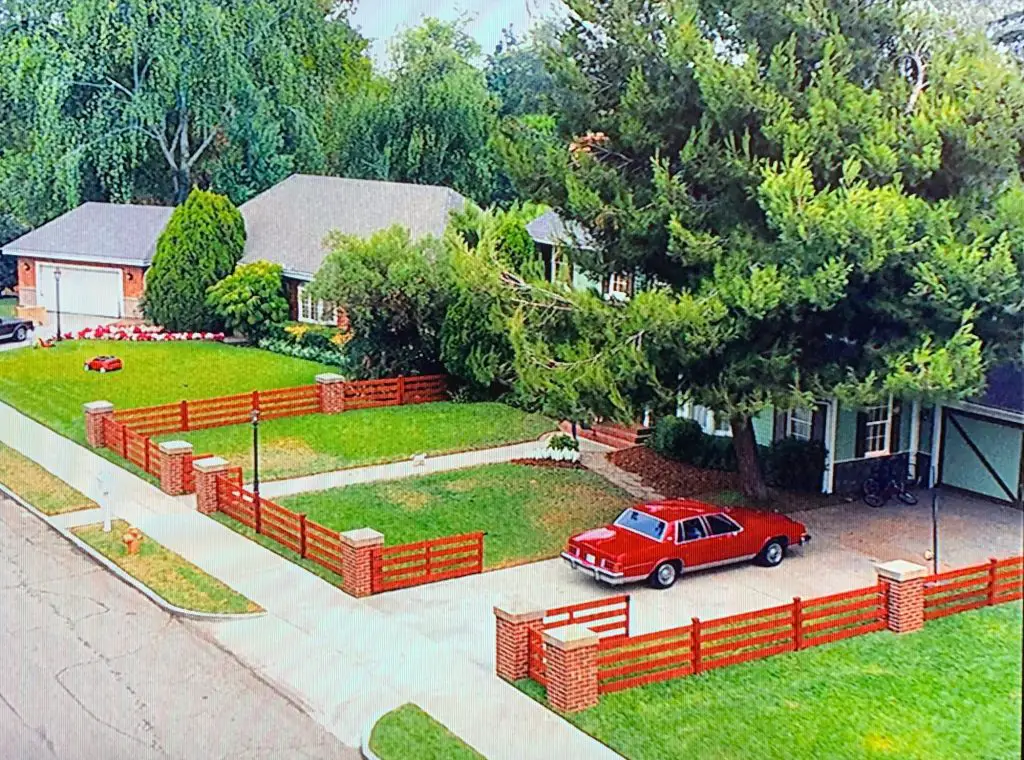
This establishing shot of Wanda’s dream home offers a different, sturdier fence, and a newer model automobile in the driveway. It is hard to see the house for the trees, but this could be a look at an episode set in the 1980s or 1990s.

Wanda’s pitch perfect 1980s workout clothes place this one chronologically, but there is not quite enough of the kitchen to be certain. Family Ties is as good a guess as any.
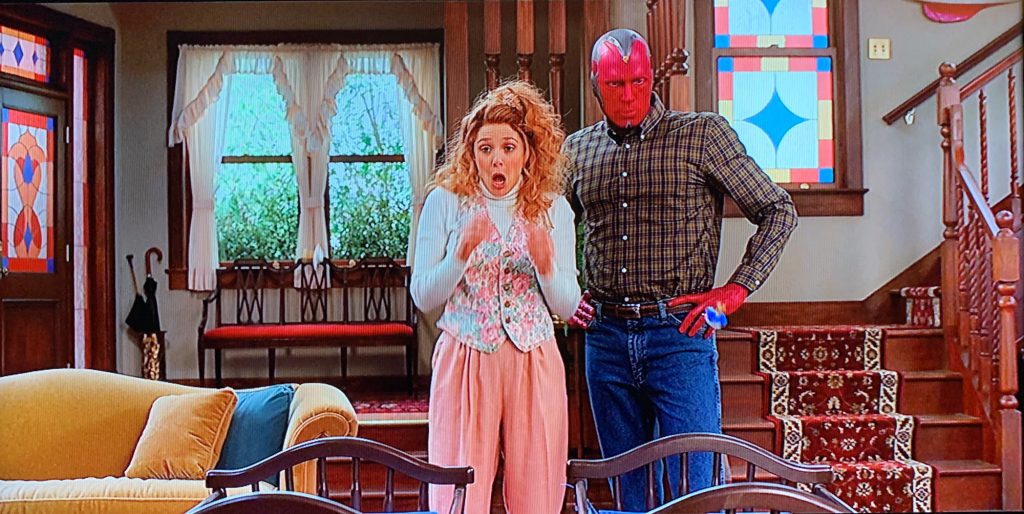
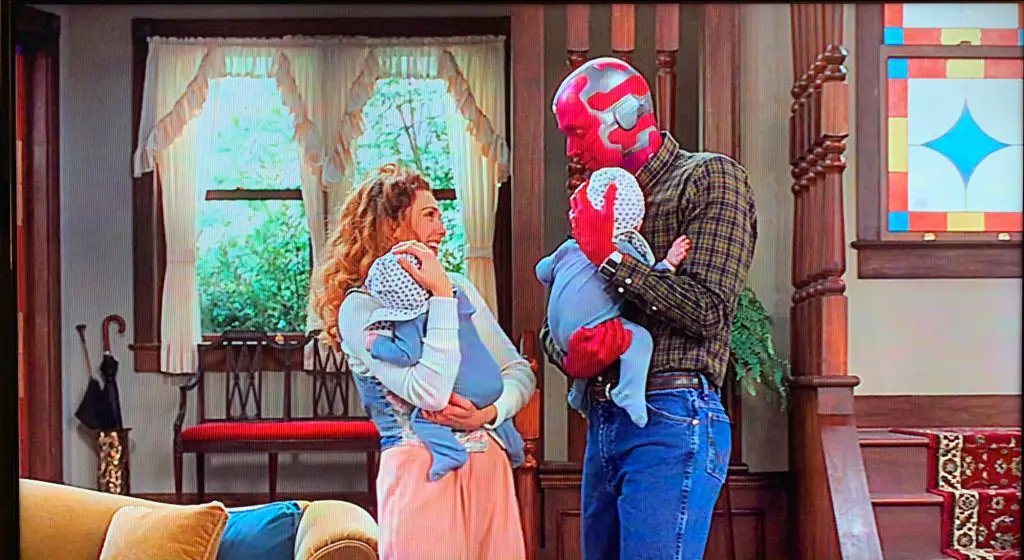
The inspiration for this one, on the other hand, is immediately identifiable. All in the Family was a major hit and cultural touchstone for America in the 1970s. This is clearly evocative of the Bunker’s house, as well as the mirror image residence that Mike and Gloria moved into across the street late in the series. (Mike and Gloria did not, however, have twins. Just baby Joey.)

Here are the Bunkers and the Stivics, on the staircase in the Queens residence that was the centerpiece of All in the Family.
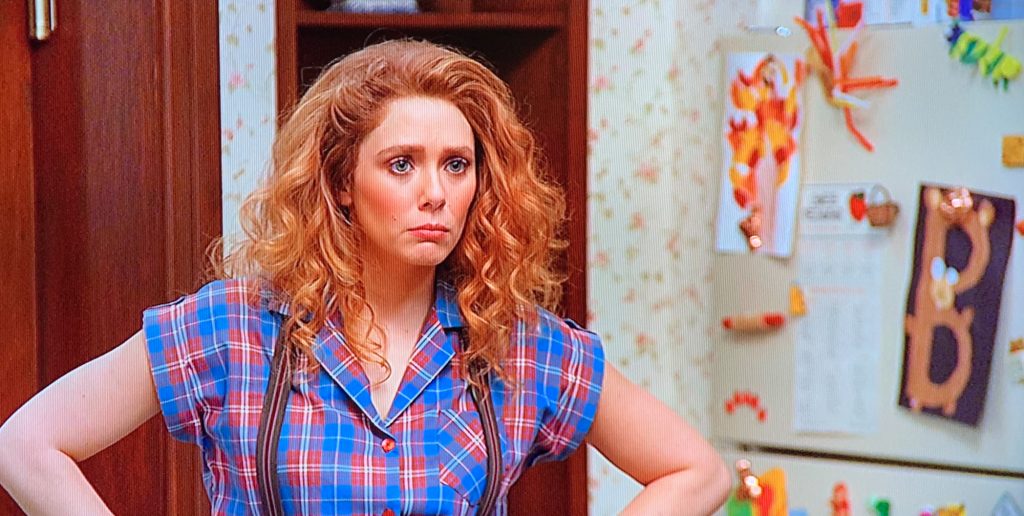
This is certainly Wanda in a very Darlene Connor state of mind.

Here is Darlene herself…
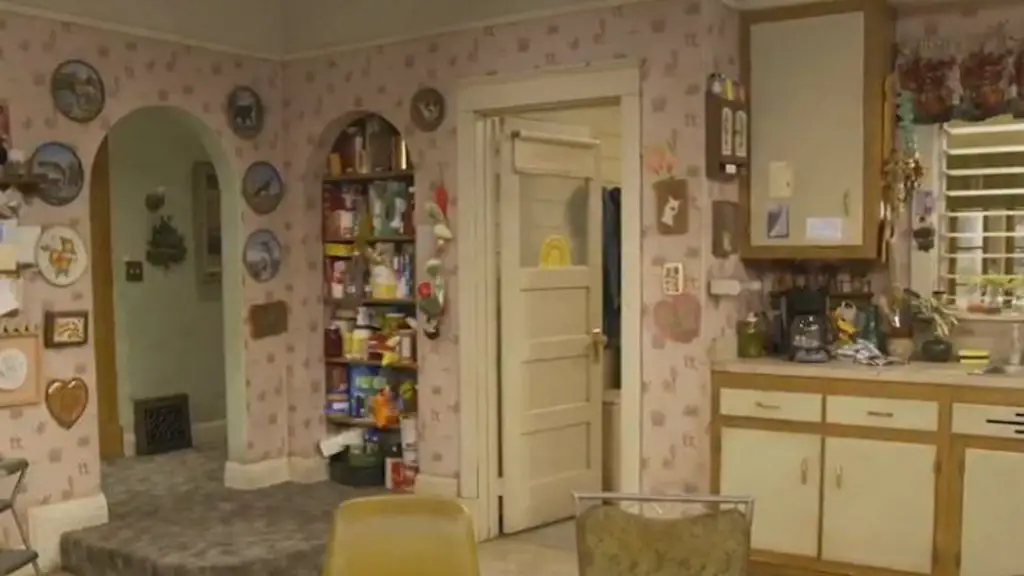
…and here is the Connor kitchen, the heart of the home throughout the run of the original series Roseanne.

And finally, here is Wanda looking a bit lost in the ever-so-tidy home of the Dunphys from Modern Family. There are at least two major visual clues in this single image.
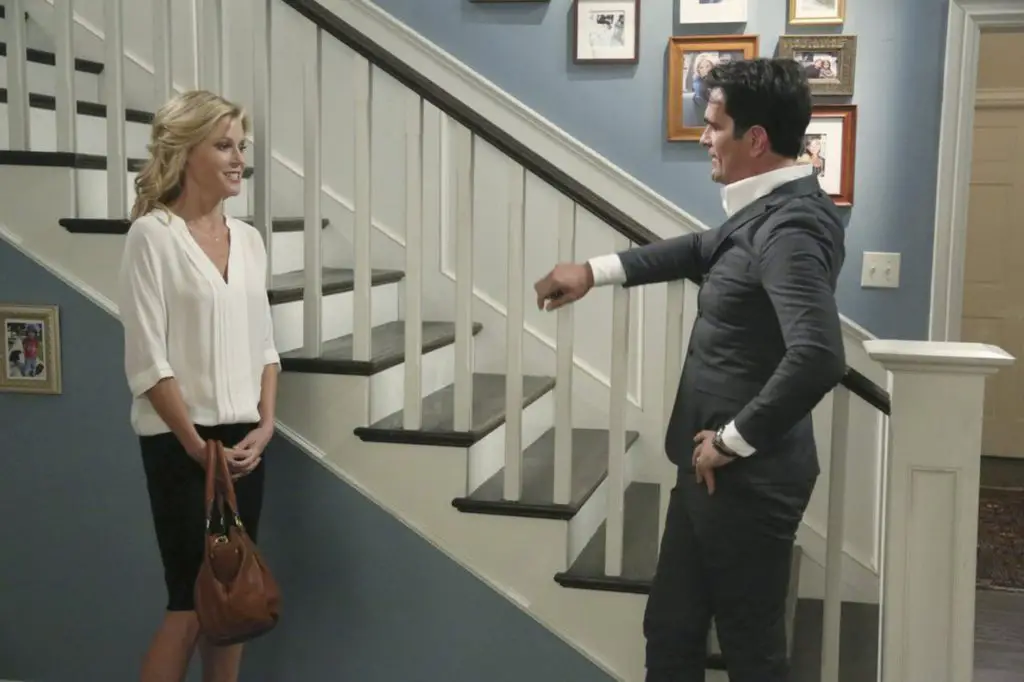
That’s the Dunphy staircase, with the square newel post, white bannisters and dark handrail. (But watch out for that loose step!)
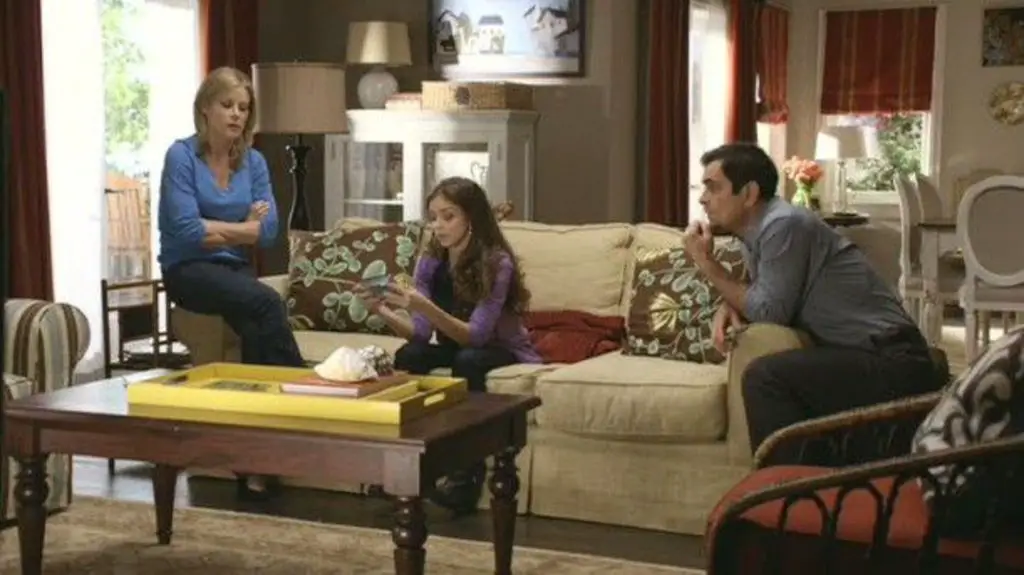
And… trays. Yes, it’s virtually the same couch, but it’s the tray on the coffee table that places it in Claire Dunphy’s world.
And that is all we have seen up until now. What sitcoms will follow? Only time and WandaVision will tell. Don’t touch that dial!
*In case you were wondering, these are all the real, fictional towns that were the primary settings for the following sitcoms: Mayberry (The Andy Griffith Show); Mayfield (Leave it to Beaver); Danfield (The Lucy Show); Springfield (Father Knows Best); Warfield (The Adventures of Ozzie and Harriet); Lanford (Roseanne); Hilldale (The Donna Reed Show); and Westbridge (Sabrina the Teenage Witch).

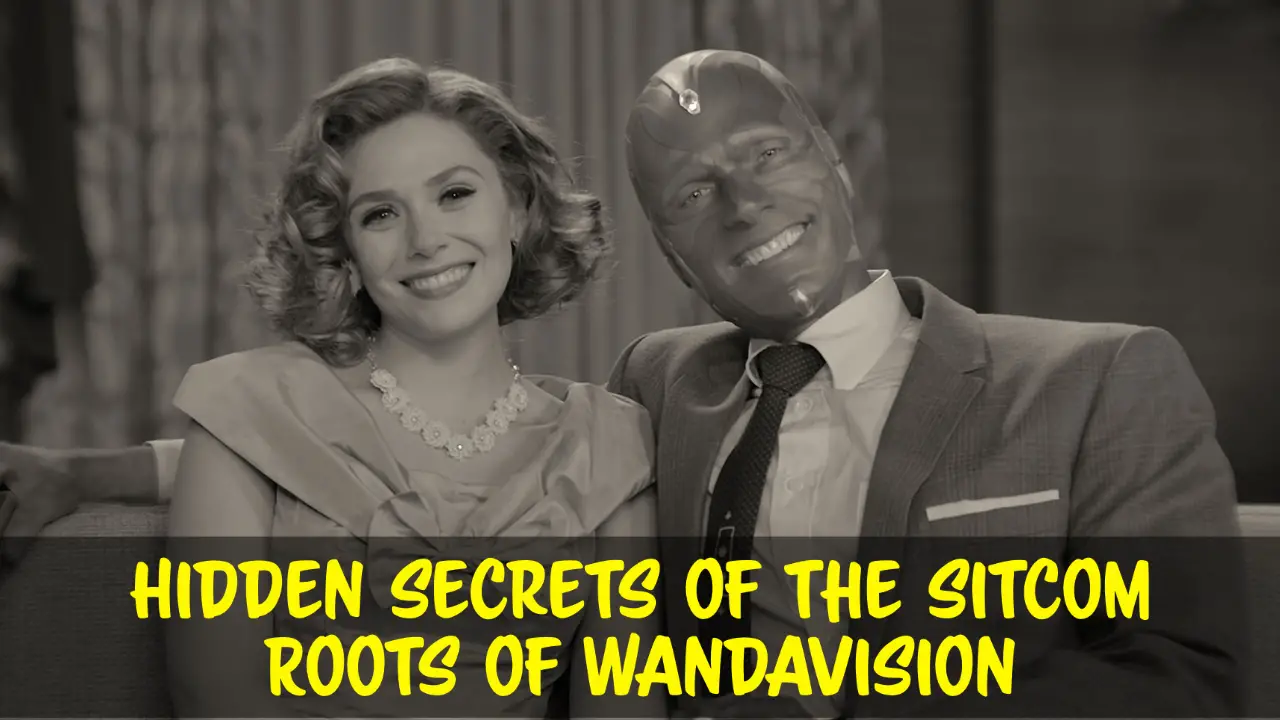

Leave a Reply